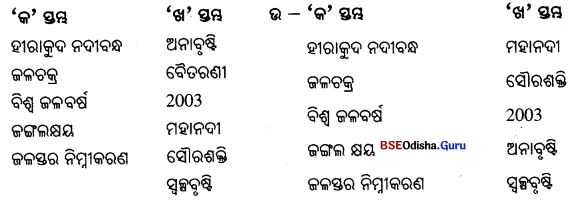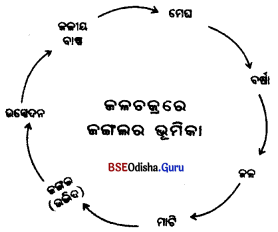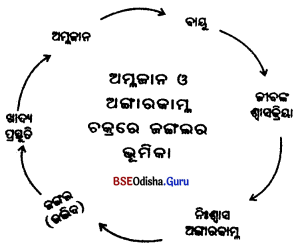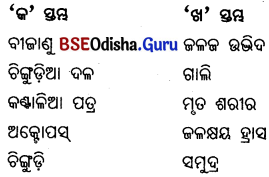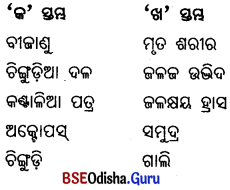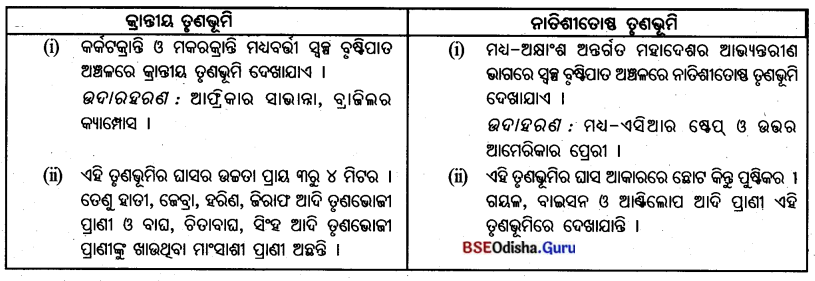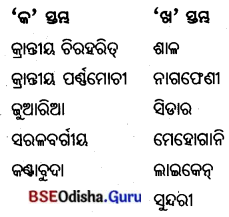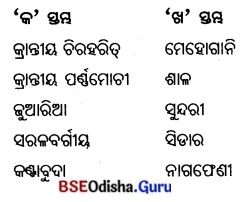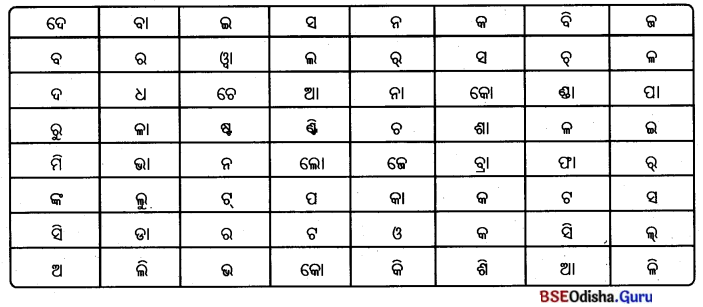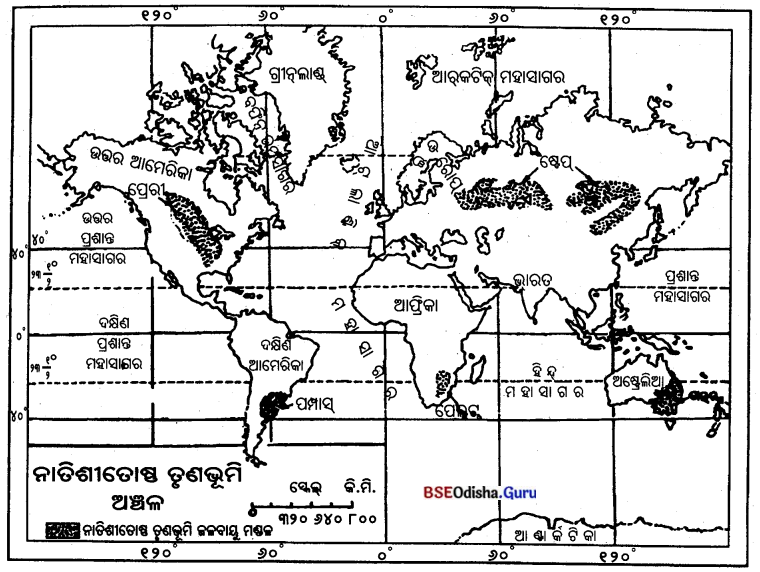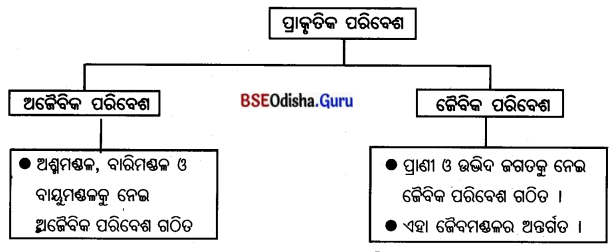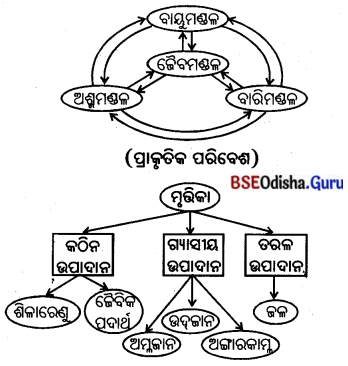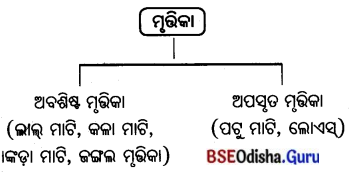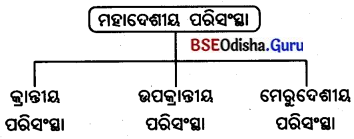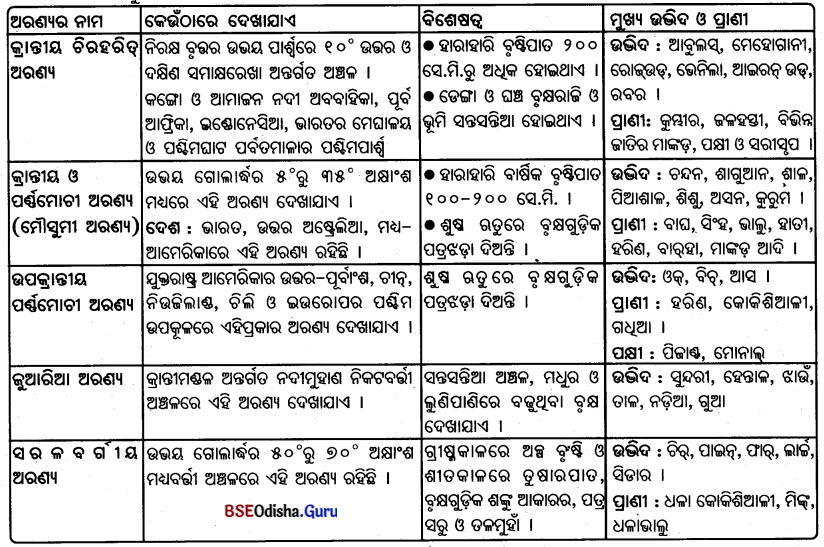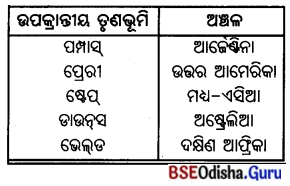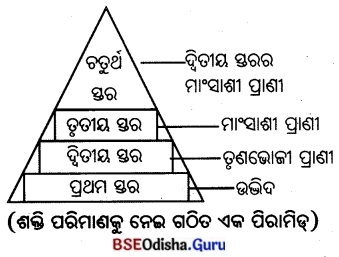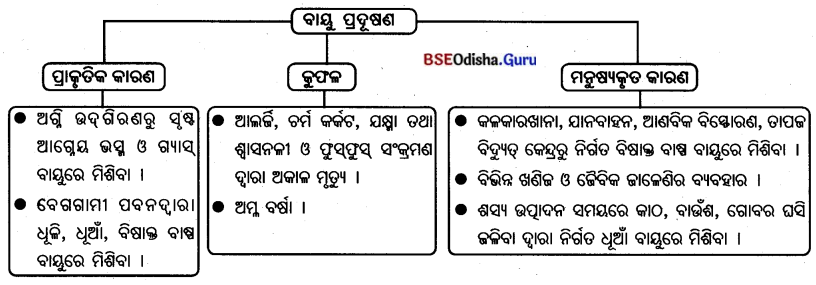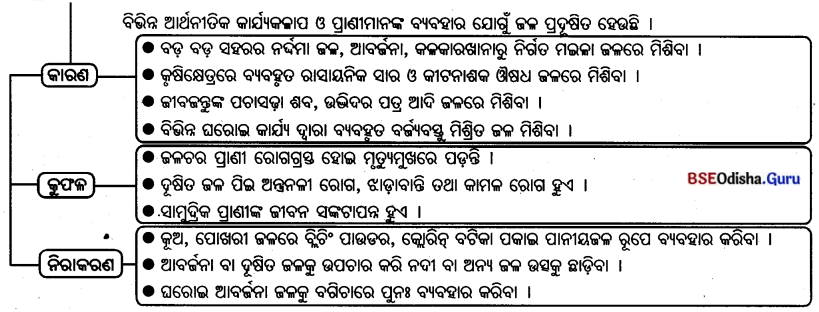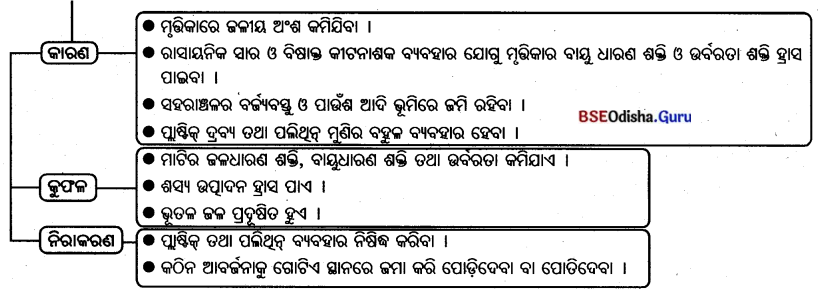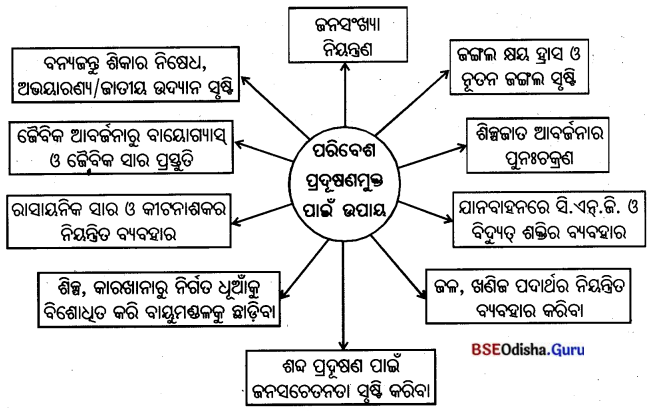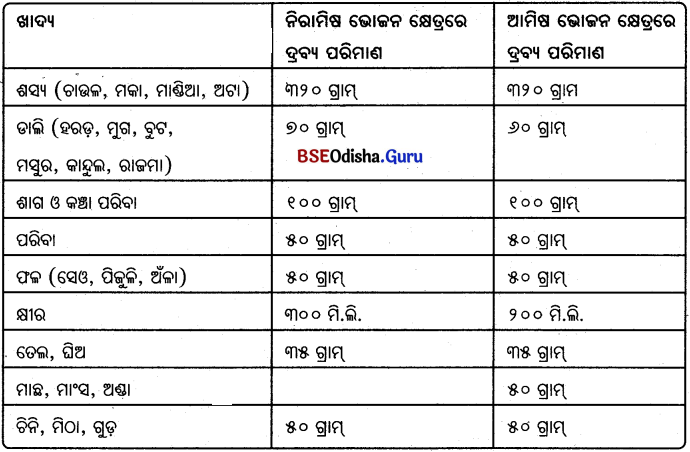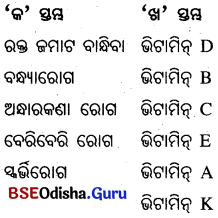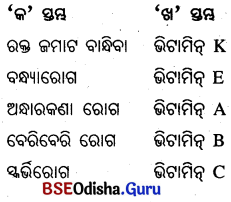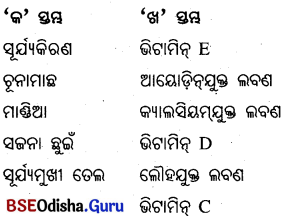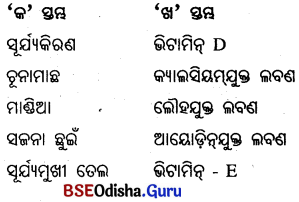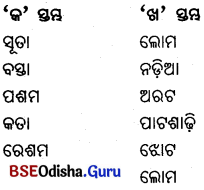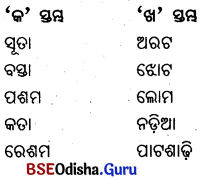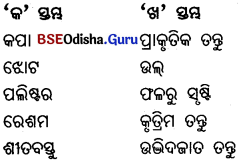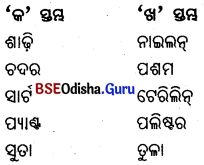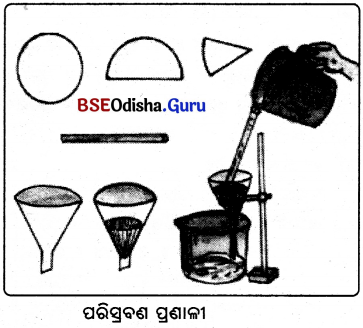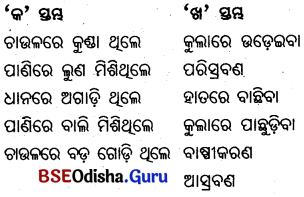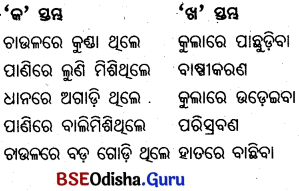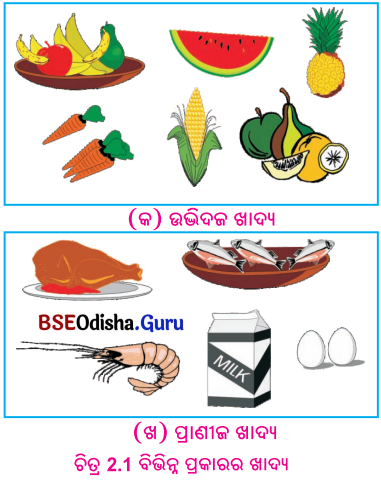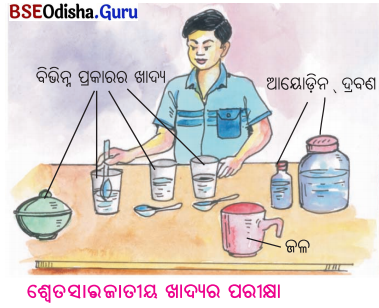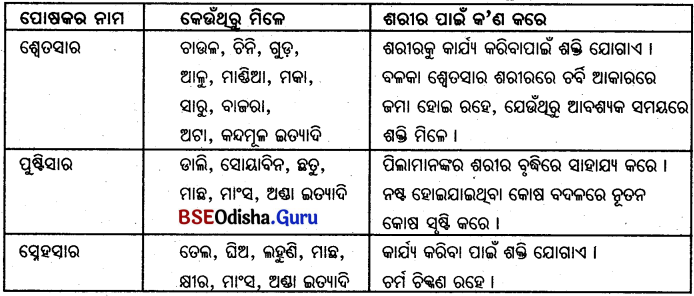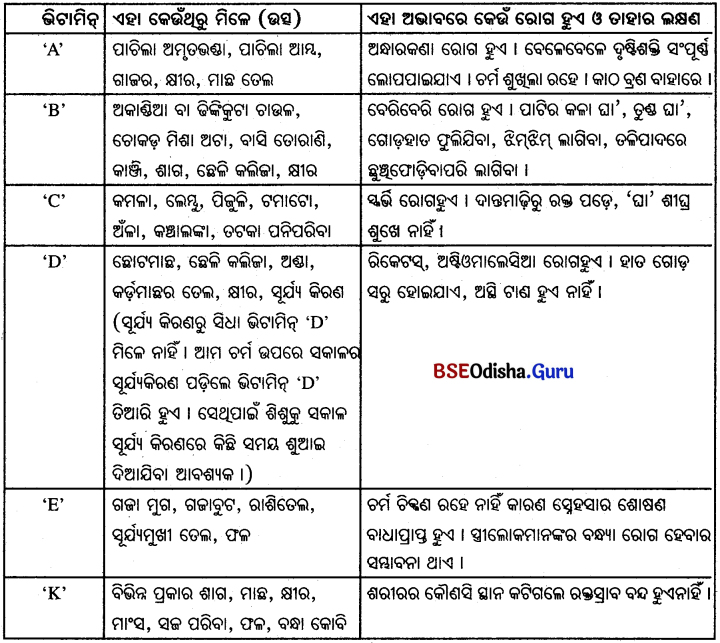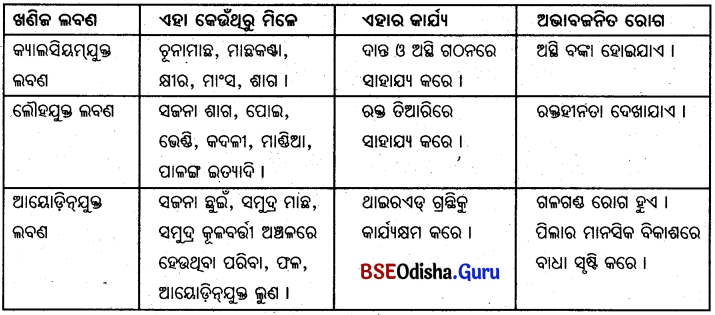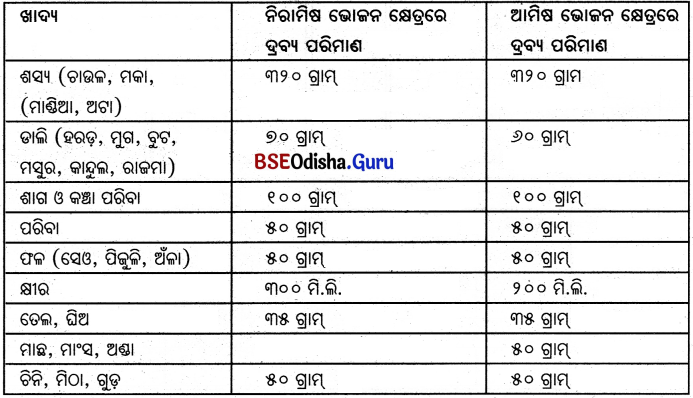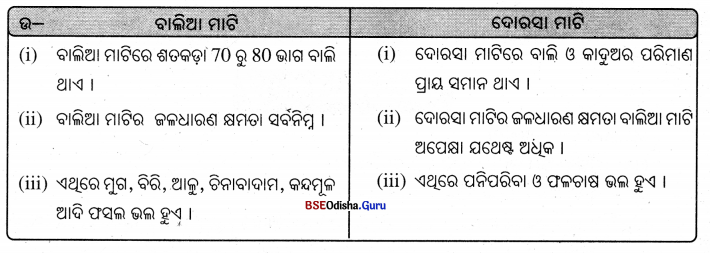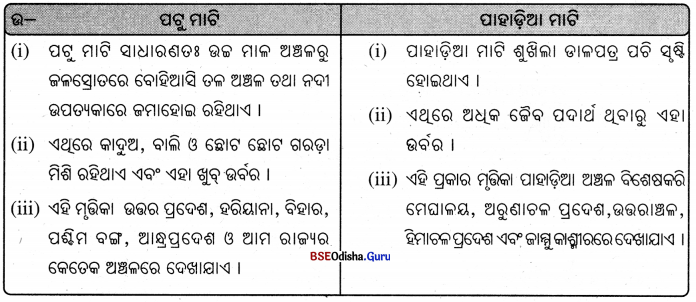Odisha State Board BSE Odisha 8th Class Geography Important Questions Chapter 4 ଶିଳ୍ପ Important Questions and Answers.
BE Odisha Class 8 Geography Important Questions Chapter 4 ଶିଳ୍ପ
Subjective Type Questions With Answers
ଦୀର୍ଘ ଉତ୍ତରମୂଳକ ପ୍ରଶ୍ନୋତ୍ତର
Question 1.
ପିଟ୍ସବର୍ଗ ଲୌହଇସ୍ପାତ କେନ୍ଦ୍ରର ଭୌଗୋଳିକ ଗୁରୁତ୍ଵ ସମ୍ବନ୍ଧରେ ଆଲୋଚନା କର ।
Answer:
- ଯୁକ୍ତରାଷ୍ଟ୍ର ଆମେରିକାର ଗୁରୁତ୍ଵପୂର୍ଣ୍ଣ ଇସ୍ପାତନଗରୀ ପିନ୍ସବର୍ଗର ଅବସ୍ଥିତି ଇସ୍ପାତ ଶିଳ୍ପ ପାଇଁ ଅନୁକୂଳ ।
- ଏଠାରେ କୋଇଲା ସମେତ କେତେକ କଞ୍ଚାମାଲ ଆସିଥାଏ ।
- 150 କି.ମି. ଦୂରରେ ଥିବା ମିନେସୋଟାରୁ ଲୁହାପଥର ଟ୍ରେନ୍ଯୋଗେ ଶସ୍ତାରେ ପରିବହନ ହୋଇ ଅଣାଯାଏ ।
- ଶସ୍ତା ପରିବହନ ପାଇଁ ବୃହତ୍ ହ୍ରହ ଜଳପଥ ମଧ୍ଯ ସୁବିଧା ଯୋଗାଇଦିଏ ।
- ଓହିଓ, ମନୋଗାହେଲା ଏବଂ ଆଲେଘେନି ନଦୀରୁ ପ୍ରଚୁର ଜଳ ମିଳିଥାଏ । ତେଣୁ ପିଟ୍ସବର୍ଗଠାରେ ବଡ଼ ବଡ଼ ଇସ୍ପାତ ଶିଳ୍ପ ଗଢ଼ିଉଠିଛି ।

Question 2.
ଓସାକା କାର୍ପାସ ଶିଳ୍ପର ଗୁରୁତ୍ଵ ବୁଝାଅ ।
Answer:
- ‘ଜାପାନର ମାଞ୍ଚେଷ୍ଟର’ ଓସାକା ଉପସାଗର କୂଳରେ ଅବସ୍ଥିତ ଏକ ବନ୍ଦର ଓ ପରିବହନ କେନ୍ଦ୍ର ।
- ସାକାକୁ ଘେରିରହିଥିବା ସୁବିସ୍ତୃତ ସମତଳଭୂମି ଶିଳ୍ପ ସ୍ଥାପନ ପାଇଁ ସୁବିଧାଜନକ ।
- ଏଠାକାର ଆର୍ଦ୍ର ଜଳବାୟୁ, ପରିବହନ ସୁବିଧା, କଞ୍ଚାମାଲ ପାଇଁ ଆବଶ୍ୟକ ରାସାୟନିକ ଦ୍ରବ୍ୟ ନିକଟବର୍ତ୍ତୀ ଅଞ୍ଚଳରୁ ସହଜରେ ସଂଗ୍ରହ ଏବଂ ଜାପାନ ଭଳି ଜନବହୁଳ ରାଷ୍ଟ୍ରରେ କାର୍ପାସବତ୍ସର ଚାହିଦା ଶିଳ୍ପର ପ୍ରସାରରେ ମୁଖ୍ୟ ଭୂମିକା ଗ୍ରହଣ କରିଛି ।
- ଓଡ଼ୋ ନଦୀରୁ ଶିଳ୍ପପାଇଁ ପ୍ରଚୁର ଜଳ ମିଳିବାସହ ବନ୍ଦର ସୁବିଧା ଥୁବାରୁ ତୁଳା ଆମଦାନି କରିବା ଓ ବସ୍ତ୍ର ରପ୍ତାନି କରିବା ସହଜ ହୋଇପାରିଛି ।
- ଏଠାକାର ବସ୍ତ୍ର ଉତ୍ତମ ମାନର ତଥା ଶସ୍ତା ହୋଇଥିବାରୁ ଏହାର ଭଲ ବଜାର ଚାହିଦା ରହିଛି ।
Question 3.
କେଉଁ କେଉଁ ଭୌଗୋଳିକ ଅବସ୍ଥା ଉପରେ ନିର୍ଭର କରି ଅହମ୍ମଦାବାଦରେ କାର୍ପାସ ଶିଳ୍ପ ଗଢ଼ିଉଠିଛି ?
Answer:
- ସାବରମତୀ ନଦୀକୂଳରେ ଅବସ୍ଥିତ ଅହମ୍ମଦାବାଦ ଗୁଜରାଟ ରାଜ୍ୟରେ ଅବସ୍ଥିତ । ଏହି ରାଜ୍ୟ କପାଚାଷ ପାଇଁ ଭାରତରେ ଖ୍ୟାତିଲାଭ କରିଛି । ଏହା କଞ୍ଚାମାଲ ଯୋଗାଣକୁ ନିଶ୍ଚିତ କରିଛି ।
- ଅହମ୍ମଦାବାଦର ଦକ୍ଷିଣରେ ମୁମ୍ବାଇ ଏବଂ ପଶ୍ଚିମରେ କାଣ୍ଡଲା ବନ୍ଦର ଅବସ୍ଥିତ । ତେଣୁ ବନ୍ଦର ମାଧ୍ୟମରେ ଯନ୍ତ୍ରପାତି ଆମଦାନି ଓ ରପ୍ତାନିର ସୁବିଧା ମିଳୁଛି ।
- ନଦୀକୂଳରେ ଅବସ୍ଥିତ ହୋଇଥିବାରୁ କାରଖାନା ଏବଂ ଶିଳ୍ପାଞ୍ଚଳ ପାଇଁ ମଧୁର ଜଳ ମିଳିଥାଏ ।
- ଏଠାରେ କୁଶଳୀ ଓ ଅର୍ଥକୁଶଳୀ ଶ୍ରମିକଙ୍କର ଅଭାବ ନାହିଁ ।
- ଅହମ୍ମଦାବାଦ ସହରଟି ଏକ ବୃହତ୍ ବାଣିଜ୍ୟ ଏବଂ ପରିବହନ କେନ୍ଦ୍ର । ତେଣୁ ବିଭିନ୍ନ ଅଞ୍ଚଳକୁ ବସ୍ତ୍ର, କପଡ଼ା ପଠାଇବା ସମ୍ଭବ ହୋଇପାରୁଛି ।
Question 4.
ଜାମସେଦପୁରଠାରେ ଥିବା ଟାଟା ଲୌହଇସ୍ପାତ ଶିଳ୍ପର ବିକାଶ ଉପରେ ଏକ ବିବରଣୀ ଲେଖ ।
Answer:
- ଭୌଗୋଳିକ ଦୃଷ୍ଟିରୁ ଜାମ୍ସେପୁର ହିଁ ଦେଶର ସବୁଠାରୁ ସୁବିଧାଜନକ ସ୍ଥିତିରେ ଥିବା ଲୌହଇସ୍ପାତ କେନ୍ଦ୍ର ।
- ଅବସ୍ଥିତି : ବେଙ୍ଗଲ୍-ନାଗପୁର ରେଳପଥ ବର୍ତ୍ତମାନର ହାୱଡ଼ା- ମୁମ୍ବାଇ ରେଳପଥର କାଳିମାଟି ଷ୍ଟେସନଠାରୁ 32 କି.ମି. ଦୂରରେ ଅବସ୍ଥିତ ।
- କଞ୍ଚାମାଲ ଉପଲବ୍ଧର ସୁବିଧା : ନିକଟସ୍ଥ ଝରିଆରୁ କୋଇଲା, ଓଡ଼ିଶା ଓ ଛତିଶଗଡ଼ରୁ ଲୁହାପଥର, ଚୂନପଥର, ଡୋଲୋମାଇଟ୍ ଓ ମାଙ୍ଗାନିଜ ସୁବିଧାରେ ଉପଲବ୍ଧ । ହୋଇଥାଏ ।
- ଜଳ ସୁଲଭତା : ଖରକାଇ ଓ ସୁବର୍ଣ୍ଣରେଖା ନଦୀଦ୍ୱୟରୁ ପ୍ରଚୁର ଜଳ କାରଖାନାକୁ ଯୋଗାଇ ଦିଆଯାଏ ।
- ବଜାର ସୁବିଧା : ଅନତିଦୂରରେ ଅବସ୍ଥିତ କୋଲକାତା ନଗରୀ ବିଶାଳ ବଜାର ପାଇଁ ସୁବିଧା ରହିଛି । ଏତଦ୍ବ୍ୟତୀତ ସରକାରୀ ପ୍ରୋତ୍ସାହନ ଯୋଗୁ ପୁଞ୍ଜିର ସୁବ୍ୟବସ୍ଥା ରହିଛି ।

Question 5.
ଶିଳ୍ପ ପ୍ରତିଷ୍ଠାନରେ ଦୁର୍ଘଟଣା ହ୍ରାସ ନିମନ୍ତେ କି କି ପଦକ୍ଷେପ ନିଆଯାଇପାରିବ ଦର୍ଶାଅ ।
Answer:
- ଶିଳ୍ପାଞ୍ଚଳଗୁଡ଼ିକୁ ଘନ ଜନବସତିପୂର୍ଣ୍ଣ ଅଞ୍ଚଳଠାରୁ ଦୂରରେ ସ୍ଥାପନ କରିବା ଉଚିତ ।
- କଳକାରଖାନା ନିକଟରେ ବସବାସ କରୁଥିବା ଲୋକମାନଙ୍କୁ ଶିଳ୍ପରେ ବ୍ୟବହୃତ ବା ଉତ୍ପାଦିତ ବିଷାକ୍ତ ପଦାର୍ଥର ସଂରକ୍ଷଣ ତଥା ଦୁର୍ଘଟଣା ଘଟିଲେ ଏହାର ସମ୍ଭାବ୍ୟ ପ୍ରଭାବ ସମ୍ବନ୍ଧରେ ସଚେତନ କରାଇବା ଆବଶ୍ୟକ ।
- ଅଗ୍ନି ସତର୍କତା ବା ଅଗ୍ନି ନିର୍ବାପନ ବ୍ୟବସ୍ଥାରେ ଉନ୍ନତିକରଣ କରାଯିବା ଆବଶ୍ୟକ ।
- ବିଷାକ୍ତ ପଦାର୍ଥଗୁଡ଼ିକର ଭଣ୍ଡାର ସୀମିତ ହେବା ଉଚିତ ।
- ଶିଳ୍ପାନୁଷ୍ଠାନମାନଙ୍କରେ ହଠାତ୍ ପ୍ରଦୂଷଣ ହେଲେ ସଙ୍ଗେ ସଙ୍ଗେ ତା’ର ଅପସାରଣ ବ୍ୟବସ୍ଥାରେ ଉନ୍ନତିକରଣ ଆବଶ୍ୟକ ।
ସଂକ୍ଷିପ୍ତ ଉତ୍ତରମୂଳକ ପ୍ରଶ୍ନୋତ୍ତର
ସଂକ୍ଷେପରେ ଉତ୍ତର ଲେଖ ।
Question 1.
କୁଟୀରଶିଳ୍ପ କ’ଣ ? ଉଦାହରଣସହ ଲେଖ ।
Answer:
- ପରିବାର ସଦସ୍ୟଙ୍କ ସହାୟତାରେ ସ୍ଥାନୀୟ କଞ୍ଚାମାଲ ଓ ସରଳ ଉପକରଣ ସାହାଯ୍ୟରେ ବିଭିନ୍ନ ବସ୍ତୁ ଉତ୍ପାଦନକରଣ କରିବା ପ୍ରକ୍ରିୟାକୁ କୁଟୀରଶିଳ୍ପ କୁହାଯାଏ ।
- ଏଥରେ ବଂଶାନୁକ୍ରମିକ କାରିଗରୀ ଜ୍ଞାନର ଉପଯୋଗ ହୋଇଥାଏ। ଉଦାହରଣ ପିପିଲିର ଚାନ୍ଦୁଆ କାମ ଏବଂ କଟକର ତାରକସୀ କାମ ଓ ନୀଳଗିରିର ପଥର ବାସନ କାମ ଇତ୍ୟାଦି ।
Question 2.
ଅହମ୍ମଦାବାଦରେ ପ୍ରଚୁର କପା ଉତ୍ପାଦନର କାରଣ କ’ଣ ?
Answer:
- ଅହମ୍ମଦାବାଦ ଚତୁଃପାର୍ଶ୍ଵ ଅଞ୍ଚଳ କପାଚାଷ ଅଞ୍ଚଳଭାବେ ପ୍ରସିଦ୍ଧ ।
- କାରଣ ଏହାର ଆର୍ଦ୍ର ଜଳବାୟୁ ଓ କୃଷ୍ଣକାର୍ପାସ ମୃତ୍ତିକା ଏହି ଚାଷ ପାଇଁ ଅନୁକୂଳ ପରିବେଶ ଯୋଗାଇଥାଏ ।
Question 3.
ଓସାକା କାର୍ପାସ ଶିଳ୍ପକୁ କଞ୍ଚାମାଲ ଯୋଗାଉଥିବା ଦେଶଗୁଡ଼ିକର ନାମ ପ୍ରକାଶ କର ।
Answer:
ଓସାକା କାର୍ପାସ ଶିଳ୍ପକୁ କଞ୍ଚାମାଲ ଯୋଗାଉଥିବା ଦେଶଗୁଡ଼ିକ ଇଜିପ୍ଟ, ଭାରତ, ଚୀନ୍ ଓ ଯୁକ୍ତରାଷ୍ଟ୍ର ଆମେରିକା ।
Question 4.
ଇସ୍ପାତର ବିଶେଷତ୍ଵ କ’ଣ ଓ~ଏଥୁରୁ ମିଶ୍ରଧାତୁ କିପରି କରାଯାଏ ?
Answer:
- ଇସ୍ପାତ ବେଶ୍ ଶକ୍ତ । ଏହାକୁ ସହଜରେ ବିଭିନ୍ନ ଆକୃତି ଦିଆଯାଇପାରେ, କଟାଯାଇପାରେ ଏବଂ ତାରରେ ପରିଣତ କରି ହୁଏ
- ଇସ୍ପାତ ସହିତ ଆଲୁମିନିୟମ୍, ନିକେଲ ଓ ତମ୍ବା ଆଦି କମ୍ମାତ୍ରାରେ ମିଶାଇ ମିଶ୍ରଧାତୁ ପ୍ରସ୍ତୁତ କରାଯାଏ ।
Question 5.
ଲୌହଇସ୍ପାତ ଶିଳ୍ପର ନିବେଶ ଉଲ୍ଲେଖ କର ।
Answer:
କଞ୍ଚାମାଲଭାବେ ଲୁହାପଥର, କୋଇଲା ଓ ଚୂନପଥର, ମାନବ, ଶ୍ରମ, ପୁଞ୍ଜି, ଭୂମି ତଥା ଅନ୍ୟାନ୍ୟ ଆଧାରିକ ସଂରଚନା ଖର୍ଚ୍ଚ ନିବେଶ କରାଯାଏ ।

Question 6.
ଚାରିଗୋଟି କୃଷିଭିତ୍ତିକ ଶିଳ୍ପର ଉଦାହରଣ ଦିଅ ।
Answer:
ଖାଦ୍ୟ ପ୍ରକ୍ରିୟାକରଣ, ଖାଇବା ତେଲ ଉତ୍ପାଦନ, କାର୍ପାସ ବୟନ, ଦୁଗ୍ଧଜାତ ପଦାର୍ଥ ପ୍ରସ୍ତୁତ ।
Question 7.
ଦୁଇଟି ଖଣିଜଭିଭିକ ଶିଳ୍ପ ଓ ଦୁଇଟି ସମୁଦ୍ରଭିତ୍ତିକ ଶିଳ୍ପର ନାମ ଲେଖ ।
Answer:
- ଖଣିଜଭିଭିକ ଶିଳ୍ପ- ଲୌହଇସ୍ପାତ ଓ ଆଲୁମିନିୟମ୍ ଶିଳ୍ପ ।
- ସମୁଦ୍ରଭିତିକ ଶିଳ୍ପ – ସାମୁଦ୍ରିକ ଖାଦ୍ୟ ଉଦ୍ୟୋଗ ଓ ମାଛତେଲ ଉଦ୍ୟୋଗ ।
Question 8.
ଉପଭୋକ୍ତା ଦ୍ରବ୍ୟ ଉତ୍ପାଦନକାରୀ ଶିଳ୍ପର ଉଦାହରଣ ଦିଅ ।
Answer:
ଉପଭୋକ୍ତା ଦ୍ରବ୍ୟ ଉତ୍ପାଦନକାରୀ ଶିଳ୍ପଗୁଡ଼ିକ ହେଲେ ଖାଇବାତେଲ, ଚା’, ସାବୁନ, ପାଉଁରୁଟି, ବିସ୍କୁଟ, ରେଡ଼ିଓ, ଟେଲିଭିଜନ୍ ଶିଳ୍ପ ଇତ୍ୟାଦି ।
Question 9.
ତିନୋଟି କ୍ଷୁଦ୍ର ଶିଳ୍ପ ଓ ତିନୋଟି କୁଟୀର ଶିଳ୍ପର ଉଦାହରଣ ଦିଅ ।
Answer:
- କ୍ଷୁଦ୍ରଶିଳ୍ପ – ଘଣ୍ଟା, ରେଡ଼ିଓ, ଟିଭି ଶିଳ୍ପ ।
- କୁଟୀରଶିଳ୍ପ – ଝୁଡ଼ିବୁଣା, ମାଟିହାଣ୍ଡି ପ୍ରସ୍ତୁତି ଓ ଶିଙ୍ଗକାମ ଇତ୍ୟାଦି ।
Question 10.
ଏକ କାର୍ପାସ ଶିଳ୍ପର ନିବେଶ ଓ ପ୍ରକ୍ରିୟାକରଣ ଦର୍ଶାଅ ।
Answer:
- ନିବେଶ – ତୁଳା, ମାନବଶ୍ରମ, ଯନ୍ତ୍ରପାତି, ପରିବହନ ଖର୍ଚ୍ଚ,
- ପ୍ରକ୍ରିୟାକରଣ – ତୁଳାଭିଣା, ସୂତାକଟା, ଲୁଗାବୁଣା, ରଙ୍ଗଲଗା, ଛାପାକାର୍ଯ୍ୟ ଓ ସିଲାଇ ।

Question 11.
ଦୁଇଟି ଶିଳ୍ପ ଦୁର୍ଘଟଣାର ନାମ ଲେଖ । ଏହି ଦୁର୍ଘଟଣାଗ୍ରସ୍ତ ପ୍ରପୀଡ଼ିତ ଲୋକଙ୍କ ଦୁର୍ଦ୍ଦଶାଗୁଡ଼ିକ ଲେଖ ।
Answer:
- ଭୋପାଳ ଗ୍ୟାସ୍ ଦୁର୍ଘଟଣା ଓ ଚୀନ୍ର ଚୋଙ୍ଗିଙ୍ଗ୍ ଅନ୍ତର୍ଗତ ଗାଓକ୍ସିଆଓ ଗ୍ୟାସ୍ କୂପ ବିସ୍ଫୋରଣ ।
- ଭୋପାଳ ଗ୍ୟାସ୍ ଦୁର୍ଘଟଣାଗ୍ରସ୍ତ ଲୋକ ଅନ୍ଧତ୍ବ, ପ୍ରତିରୋଧକାରୀ ଶକ୍ତିହୀନତା ଓ ବିଭିନ୍ନ ପେଟରୋଗରେ, ପୀଡ଼ିତ । ଗାଓକ୍ସିଆଓ ଗ୍ୟାସ୍ କୂପ ଦୁର୍ଘଟଣାଗ୍ରସ୍ତ ଲୋକମାନେ ଆଖୁ, ଚର୍ମ ଓ ଫୁସ୍ଫୁସ୍ ଜଳାପୋଡ଼ାରେ ପୀଡ଼ିତ ।
Question 12.
ସୂର୍ଯ୍ୟୋଦୟ ଶିଳ୍ପ କ’ଣ ? ଉଦାହରଣସହ ବୁଝାଅ ।
Answer:
- ନୂତନଭାବେ ଗଢ଼ିଉଠିଥିବା ଶିଳ୍ପକୁ ସୂର୍ଯ୍ୟୋଦୟ ଶିଳ୍ପ କୁହାଯାଏ ।
- ଉଦାହରଣସ୍ୱରୂପ- ସୂଚନା ପ୍ରଯୁକ୍ତି ବିଦ୍ୟା, ସ୍ୱାସ୍ଥ୍ୟ ଓ ସ୍ଵାସ୍ଥ୍ୟସେବା, ଆତିଥ୍ୟ ଏବଂ ଶିକ୍ଷା ।
Question 13.
ମାଞ୍ଚେଷ୍ଟର କାହିଁକି ପ୍ରସିଦ୍ଧ ?
Answer:
- ମାଞ୍ଚେଷ୍ଟର ଇଂଲଣ୍ଡର ଏକ କାର୍ପାସ ଓ ବୟନ ଶିଳ୍ପର ପ୍ରଧାନ ସହର ।
- ଏଠାରେ ଶିଳ୍ପବିପ୍ଳବ ପରେ କଳତନ୍ତ ବୟନଶିଳ୍ପ ପ୍ରତିଷ୍ଠା ହେଲା । ଭାରତରୁ କଞ୍ଚାମାଲ ରୂପେ ତୁଳା ଓ ଝୋଟ ଆମଦାନୀ କରାଯାଉଥିଲା ।
Question 14.
ଭାରତର ବେଙ୍ଗାଲୁରୁ ବ୍ୟତୀତ ଆଉ ଚାରିଗୋଟି ସୂଚନା ପ୍ରଯୁକ୍ତିବିଦ୍ୟା କେନ୍ଦ୍ରର ନାମ ଲେଖ ।
Answer:
ଭାରତର ଚାରିଗୋଟି ସୂଚନା ପ୍ରଯୁକ୍ତିବିଦ୍ୟା କେନ୍ଦ୍ରଗୁଡ଼ିକ ହେଲେ ଗୁଡ଼ଗାଓଁ, ପୁଣେ, ଭୁବନେଶ୍ବର ଓ ଥୁରୁ ଅନନ୍ତପୁରମ୍ ।
Question 15.
ଭାରତର ଚାରିଗୋଟି ଶିଳ୍ପାଞ୍ଚଳର ନାମ ଲେଖ ।
Answer:
- ଭାରତର ଚାରୋଟି ଶିଳ୍ପାଞ୍ଚଳର ନାମ ହେଲା-
- ମୁମ୍ବାଇ- ପୁଣେ ଶିଳ୍ପାଞ୍ଚଳ
- ବେଙ୍ଗାଲୁରୁ-ତାମିଲନାଡୁ ଅଞ୍ଚଳ
- ହୁଗୁଳି ଅଞ୍ଚଳ
- ଅହମ୍ମଦାବାଦ–ଭଦୋଦରା ଶିଳ୍ପାଞ୍ଚଳ ।

Question 16.
ଶିଳ୍ପ କହିଲେ କ’ଣ ବୁଝାଯାଏ ?
Answer:
- ଯେଉଁ ଅର୍ଥନୀତିକ କାର୍ଯ୍ୟକଳାପଦ୍ବାରା ନୂତନ ସାମଗ୍ରୀ ପ୍ରସ୍ତୁତକରିବା ସହ ଖଣିଜଦ୍ରବ୍ୟ ଉତ୍ତୋଳନ ତଥା ସେବା ଯୋଗାଇ ଦିଆଯାଏ ତାହାକୁ ଶିଳ୍ପ କୁହାଯାଏ ।
- ଉଦାହରଣସ୍ୱରୂପ ଲୌହଇସ୍ପାତ ଶିଳ୍ପରୁ ବିଭିନ୍ନ ଇସ୍ପାତ ସାମଗ୍ରୀ ପ୍ରସ୍ତୁତ କରାଯାଏ । କୋଇଲା ଖନନ ଶିଳ୍ପରେ କୋଇଲା ଉତ୍ପାଦନ କରାଯାଏ ।
- ପରିବହନ, ଯୋଗାଯୋଗ, ପର୍ଯ୍ୟଟନ ଆଦି ମଧ୍ଯ ସେବାରିରିକ ଶିଳ୍ପ ।
Question 17.
ଭାରତୀୟ ସୂଚନା ପ୍ରଯୁକ୍ତି ଶିଳ୍ପସଂସ୍ଥାର ନାମ ଲେଖ ।
Answer:
ଭାରତରେ ସୂଚନା ପ୍ରଯୁକ୍ତି ଶିଳ୍ପ ସଂସ୍ଥାର ନାମ ହେଲା – ଇନ୍ଫୋସିସ୍, ୱିପ୍ରୋ ଓ ସତ୍ୟମ୍ ।
Question 18.
ଗୋଟିଏ ଦେଶ ପାଇଁ ଶିଳ୍ପର ବିକାଶ କାହିଁକି ମହତ୍ତ୍ଵପୂର୍ଣ ? ଦୁଇଟି କାରଣ ଲେଖ ।
Answer:
- ଶିଳ୍ପ ପ୍ରତି ଦ୍ଵାରା ଲୋକ ମାନଙ୍କୁ କର୍ମସଂସ୍ଥାନ ମିଳିଥାଏ ।
- ଏହାଦ୍ୱାରା ବ୍ୟବସାୟ ବାଣିଜ୍ୟ କାରବାର ବୃଦ୍ଧିପାଏ ଏବଂ ଦେଶର ଆୟ ମଧ୍ୟ ବଢ଼େ ।
- ଜଣେ ଶିଳ୍ପ ଶ୍ରମିକ, ଜଣେ କୃଷି ଶ୍ରମିକଠାରୁ ଅଧିକ ମଜୁରି ପାଏ ।
- ଶିଳ୍ପାୟନ ଦେଶକୁ ଅର୍ଥନୀତି କ୍ଷେତ୍ରରେ ସମୃଦ୍ଧ କରେ ।
Question 19.
ଶିଳ୍ପ ପ୍ରତିଷ୍ଠା ପାଇଁ କେଉଁ କେଉଁ କାରଣଗୁଡ଼ିକ ମୁଖ୍ୟତଃ ଦାୟୀ ?
Answer:
- କଞ୍ଚାମାଲର ଉପଲବ୍ଧି
- ଶିଳ୍ପ ପ୍ରତିଷ୍ଠା ପାଇଁ ଆବଶ୍ୟକ ଜମି
- ଜଳ
- କୁଶଳୀ ଓ ଶସ୍ତା ଶ୍ରମିକ, ଶକ୍ତି, ପୁଞ୍ଜି, ପରିବହନ ଓ ବଜାର ଇତ୍ୟାଦି
- ଏତଦ୍ବ୍ୟତୀତ ସରକାରଙ୍କଦ୍ୱାରା ରିହାତି ଦରରେ ଉପରୋକ୍ତ ଆନୁଷଙ୍ଗିକ ବ୍ୟବସ୍ଥା ଯୋଗାଇଦେବା ଆବଶ୍ୟକ ।

Question 20.
କେଉଁ ଶିଳ୍ପକୁ ଆଧୁନିକ ଶିଳ୍ପର ମେରୁଦଣ୍ଡ ବୋଲି କୁହାଯାଏ ଏବଂ କାହିଁକି ?
Answer:
- ଲୌହ-ଇସ୍ପାତ ଶିଳ୍ପକୁ ଆଧୁନିକ ଶିଳ୍ପର ମେରୁଦଣ୍ଡ ବୋଲି କୁହାଯାଏ ।
- କାରଣ ଏହା ଏକ ମୌଳିକ ଶିଳ୍ପ । ଏହାର ଉତ୍ପାଦକୁ ଅନ୍ୟାନ୍ୟ ଶିଳ୍ପରେ କଞ୍ଚାମାଲ ରୂପେ ବ୍ୟବହାର କରାଯାଏ ।
- ଜଳଜାହାଜ, ରେଳଗାଡ଼ି, ଟ୍ରକ୍, ବସ୍, ଅଟୋ, ସାଇକେଲ ଆଦି ଯାନବାହନଗୁଡ଼ିକ ଲୌହ-ଇସ୍ପାତରେ ତିଆରି ।
- ଛୁଞ୍ଚଠାରୁ ଆରମ୍ଭ କରି ସେଫ୍ଟିପିନ୍ ପର୍ଯ୍ୟନ୍ତ ଅନେକ ଘରକରଣା ଜିନିଷ, ତୈଳଖଣି ଖନନ ପାଇଁ ଯନ୍ତ୍ରପାତି, ଚାଷକାର୍ଯ୍ୟ, ସୁଉଚ୍ଚ ଅଟ୍ଟାଳିକାରେ ବ୍ୟବହୃତ ଇସ୍ପାତ ଫ୍ରେମ୍ ଆଦି ଇସ୍ପାତରୁ ତିଆରି ।
ଭୌଗୋଳିକ କାରଣ ଦର୍ଶାଅ ।
Question 1.
ମୁମ୍ବାଇ ଭାରତର ଅନ୍ୟତମ ଆଧୁନିକ କାର୍ପାସ ବୟନଶିଳ୍ପ କେନ୍ଦ୍ର ରୂପେ ପରିଗଣିତ ।
Answer:
ମୁମ୍ବାଇର ଉଷ୍ଣ ଆର୍ଦ୍ର ଜଳବାୟୁ, ଯନ୍ତ୍ରପାତି ଆମଦାନୀ ପାଇଁ ବନ୍ଦର । ସୁବିଧା, କଞ୍ଚାମାଲର ସୁଲଭତା ଏବଂ କୁଶଳୀ ଶ୍ରମିକ ଆଦି ଏହାକୁ ଆଧୁନିକ କାର୍ପାସ ବୟନ ଶିଳ୍ପ କେନ୍ଦ୍ର ରୂପେ ପରିଣତ କରିବାରେ ସହାୟକ ହେଲା ।
Question 2.
ଲୌହଇସ୍ପାତ ଶିଳ୍ପର ବିକାଶ ହିଁ ଭାରତରେ ଶିଳ୍ପ ବିକାଶର ଦ୍ଵାର ଖୋଲିଦେଲା ।
Answer:
- ପ୍ରତ୍ୟେକ ଶିଳ୍ପାନୁଷ୍ଠାନ ସେମାନଙ୍କର ମୌଳିକ ଆଧାରିକ ସଂରଚନା ନିମନ୍ତେ ଲୌହଇସ୍ପାତ ଶିଳ୍ପ ଉପରେ ନିର୍ଭରଶୀଳ ।
- ଲୌହଇସ୍ପାତର ଶେଷ ଉତ୍ପାଦର୍ବେ ଲୁହା ବା ଇସ୍ପାତକୁ କଞ୍ଚାମାଲ ଭାବେ ଦ୍ଵିତୀୟକ ଉତ୍ପାଦନକାରୀ ସଂସ୍ଥା, ରୋଲିଂ ମିଲ୍ ଟ୍ରକ୍ ନିର୍ମାଣ, ମଟରଗାଡ଼ି ଯନ୍ତ୍ରାଂଶ, କୃଷି ଯନ୍ତ୍ରପାତି, ରେଳଧାରଣା, କଳକବଜା, ଟିଣଚଦର, କେବୁଲ ଓ ତାର ଉତ୍ପାଦନକାରୀ ଶିଳ୍ପସଂସ୍ଥାରେ ବ୍ୟବହାର କରାଯାଏ ।
- ତେଣୁ ଲୌହଇସ୍ପାତ କେନ୍ଦ୍ରକୁ ଭିରି କରି ଭାରତରେ ଅନେକ ଶିଳ୍ପସଂସ୍ଥା ଗଢ଼ିଉଠିଛି ।
Question 3.
ଖଣିଜରିରିକ ଶିଳ୍ପଗୁଡ଼ିକୁ ମୌଳିକ ଶିଳ୍ପ କୁହାଯାଏ ।
Answer:
- ଖଣିଜରିରିକ ଶିଳ୍ପଗୁଡ଼ିକ ବିଭିନ୍ନ ଖଣିଜପଦାର୍ଥକୁ କଞ୍ଚାମାଲ ରୂପେ ବ୍ୟବହାର କରିଥା’ନ୍ତି । ଏଠାରୁ ପ୍ରସ୍ତୁତ ସାମଗ୍ରୀ ଅନ୍ୟାନ୍ୟ ଶିଳ୍ପରେ କଞ୍ଚାମାଲ ଭାବେ ବ୍ୟବହୃତ ହୁଏ । ଉଦାହରଣସ୍ୱରୂପ– ଲୌହଇସ୍ପାତ ଶିଳ୍ପରେ ଲୁହାପଥର କଞ୍ଚାମାଲ ଓ ଲୁହା ବା ଇସ୍ପାତ ଉତ୍ପାଦ ହୋଇଥାଏ ।
- ଲୁହା କଞ୍ଚାମାଲ ଭାବେ ଭାରୀ ଯନ୍ତ୍ରପାତି, ରେଳଡ଼ବା ନିର୍ମାଣ ତଥା ଜଳଜାହାଜ କାରଖାନା ଆଦିରେ ମୁଖ୍ୟ କଞ୍ଚାମାଲ ଭାବେ ବ୍ୟବହୃତ ହୁଏ ।

Question 4.
କାର୍ପାସ ବୟନ ଶିଳ୍ପ ପୃଥିବୀର ଏକ ପୁରାତନ ଶିଳ୍ପ
Answer:
- ଅଷ୍ଟାଦଶ ଶତାବ୍ଦୀରେ ସୂତା ଓ ହସ୍ତତନ୍ତଦ୍ୱାରା ବୟନଶିଳ୍ପର ବିକାଶ ଆରମ୍ଭ ହୋଇଥିଲା ।
- ଏହି ଶତାବ୍ଦୀରେ କଳତନ୍ତ୍ରଦ୍ଵାରା ଏହି ଶିଳ୍ପର ପ୍ରସାର ପ୍ରଥମେ ଗ୍ରେଟ୍ବ୍ରିଟେନ୍ ଓ ପରେ ଅନ୍ୟ ଅଞ୍ଚଳକୁ କଳତନ୍ତ୍ରର ପ୍ରସାର ଘଟିଲା, ତେଣୁ ଏହା ଏକ ପୁରାତନ ଶିଳ୍ପ ।
Question 5.
ଇସ୍ପାତ ଆଧୁନିକ ଶିଳ୍ପଜଗତର ମେରୁଦଣ୍ଡ ସଦୃଶ।
Answer:
- ଛୁଅ, ସେଫଟିପିଠାରୁ ଆରମ୍ଭ କରି ଜଳଜାହାଜ, ରେଳଗାଡ଼ି, ଟ୍ରକ୍, ବସ୍, ଅଟୋ, ସାଇକେଲ୍ ଆଦି ବିଭିନ୍ନ ଜିନିଷରେ ଇସ୍ପାତର ବ୍ୟବହାର ହୋଇଥାଏ।
- ଲୌହ-ଇସ୍ପାତର ବହୁଳ ବ୍ୟବହାର ଯୋଗୁ ଏହାକୁ ଶିଳ୍ପ ଜଗତର ମେରୁଦଣ୍ଡ ବୋଲି କୁହାଯାଏ ।
ପାର୍ଥକ୍ୟ ଦର୍ଶାଅ ।
1. କୃଷିଭିତ୍ତିକ ଶିଳ୍ପ ଓ ଖଣିଳଭିଭିକ ଶିଳ୍ପ :
Answer:
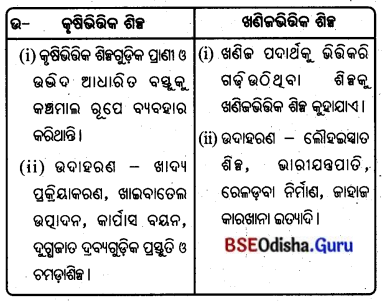
2. ସମୁଦ୍ରଭିତ୍ତିକ ଶିଳ୍ପ ଓ ଜଙ୍ଗଲଭିତ୍ତିକ ଶିଳ୍ପ :
Answer:
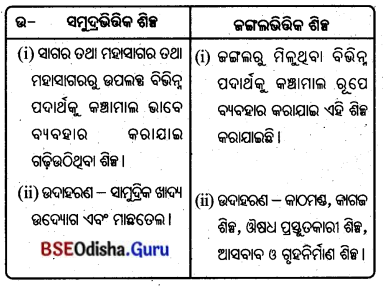
3. କୁଟୀର ଶିଳ୍ପ ଓ କ୍ଷୁଦ୍ର ଶିଳ୍ପ :
Answer:
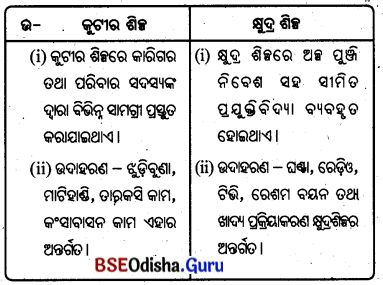
4. ପ୍ରାକୃତିକ ତନ୍ତୁ ଓ ମନୁଷ୍ୟକୃତ ତନ୍ତୁ :
Answer:
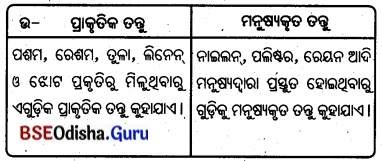
5. କ୍ଷୁଦ୍ର ଶିଳ୍ପ ଓ ବୃହତ୍ ଶିଳ :
Answer:
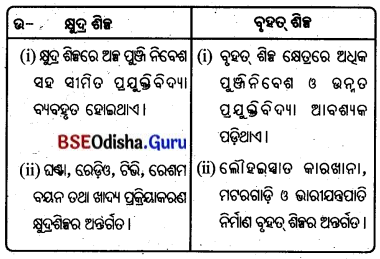

6. ବ୍ୟକ୍ତି ମାଲିକାନା ଓ ସରକାରୀ ମାଲିକାନା :
Answer:
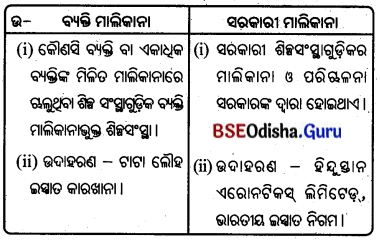
7. ଦ୍ଵୈତ ମାଲିକାନା ଓ ସମବାୟ ଶିଳ୍ପ :
Answer:
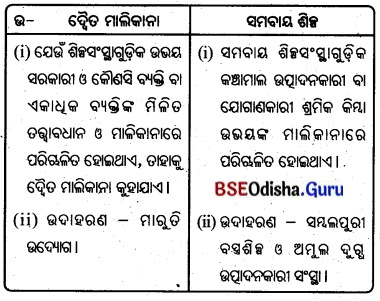
ପରୀକ୍ଷା ଉପଯୋଗୀ ସମ୍ଭାବିତ ପ୍ରଶ୍ନୋତ୍ତର
ବସ୍ତୁନିଷ୍ଠ ପ୍ରଶ୍ନୋତ୍ତର
ଶୂନ୍ୟସ୍ଥାନ ପୂରଣ କର ।1. ______ ରାଜ୍ୟ ସର୍ବପ୍ରଥମେ ସୂଚନା ଓ ପ୍ରଯୁକ୍ତି ବିଦ୍ୟା ଆଇନ୍ ପ୍ରଣୟନ କରିଥିଲେ ।
Answer:
କର୍ଣାଟକ
2. ଆମେରିକାର ସିଲିକନ୍ ଉପତ୍ୟକା ______ ଉପତ୍ୟକାର ଏକ ଅଂଶ ।
Answer:
ଶାନ୍ତାକ୍କାରା
3. ଶାନ୍ତାକାରୀ ଉପତ୍ୟକା ______ ପର୍ବତ ସହ ସଂଲଗ୍ନ ।
Answer:
ରକି
4. ଓସାକାର ______ ଶିଳ୍ପ କଞ୍ଚାମାଲ ପାଇଁ ବାହାର ଦେଶ ଉପରେ ନିର୍ଭରଶୀଳ ।
Answer:
ବୟନ

5. କଳତନ୍ତ ପ୍ରଥମେ ______ ଦେଶରେ ପ୍ରସାରିତ ହୋଇଥିଲା ।
Answer:
ଗ୍ରେଟ୍ ବ୍ରିଟେନ୍
6. ଲିନେନ୍ ______ ତନ୍ତୁ ଅଟେ ।
Answer:
ପ୍ରାକୃତିକ
7. ବୃହତ୍ ହ୍ରଦ ଅଞ୍ଚଳରୁ ______ସାହାଯ୍ୟରେ ଲୁହାପଥର ପିଟ୍ସବର୍ଗକୁ ଆସିଥାଏ।
Answer: ଟ୍ରନ୍
8. ପିଟସ୍ବର୍ଗଠାରୁ ମିନେସୋଟାର ଦୂରତା ______କି.ମି. ।
Answer:
୧୫୦୦
9. ରୋଲିଂ ମିଲ୍ ______ କାରଖାନା ସହ ସଂପୃକ୍ତ ।
Answer:
ଲୌହ-ଇସ୍ପାତ
10. ଜାମସେଦପୁର ଝାଡ଼ଖଣ୍ଡର ______ ଜିଲ୍ଲାରେ ଅବସ୍ଥିତ ।
Answer:
ସିଂହଭୂମି
ଗୋଟିଏ ବାକ୍ୟରେ ଉତ୍ତର ଦିଅ ।
Question 1.
ପ୍ରାଥମିକ ଉତ୍ପାଦ କାହାକୁ କୁହାଯାଏ ?
Answer:
ଯେଉଁ ପ୍ରକୃତିଦର ଜିନିଷଗୁଡ଼ିକ ପ୍ରତ୍ୟକ୍ଷ ଭାବରେ ବ୍ୟବହାର ହୋଇପାରେ ସେଗୁଡ଼ିକୁ ପ୍ରାଥମିକ ଉତ୍ପାଦ କୁହାଯାଏ।
Question 2.
ଶିଳ୍ପ କାହାକୁ କୁହାଯାଏ ?
Answer:
ଯେଉଁ ଆର୍ଥନୀତିକ କାର୍ଯ୍ୟକଳାପଦ୍ଵାରା ନୂତନ ସାମଗ୍ରୀ ପ୍ରସ୍ତୁତ କରିବା ସହ ଖଣିଜ ଦ୍ରବ୍ୟ ଉତ୍ତୋଳନ ତଥା ସେବା ଯୋଗାଇ ଦିଆଯାଏ, ତାହାକୁ ଶିଳ୍ପ କୁହାଯାଏ।
Question 3.
ସମୁଦ୍ରଭିତ୍ତିକ ଶିଳ୍ପ କାହାକୁ କୁହାଯାଏ ?
Answer:
ସମୁଦ୍ରଭିଭିକ ଶିଳ୍ପରେ ସାଗର ତଥା ମହାସାଗରରୁ ଉପଲବ୍ଧ ବିଭିନ୍ନ ପଦାର୍ଥକୁ କଞ୍ଚାମାଲ ଭାବେ ବ୍ୟବହାର କରାଯାଏ। ସାମୁଦ୍ରିକ ଖାଦ୍ୟ ଉଦ୍ୟୋଗ ଏବଂ ମାଛତେଲ ଉଦ୍ୟୋଗ ଏହାର ଉଦାହରଣ।

Question 4.
କେଉଁ କାର୍ଯ୍ୟଗୁଡ଼ିକ କୁଟୀର ଶିଳ୍ପର ଅନ୍ତର୍ଗତ ?
Answer:
ଝୁଡ଼ିବୁଣା, ମାଟିହାଣ୍ଡି ପ୍ରସ୍ତୁତି ଏବଂ ଅନ୍ୟାନ୍ୟ ହସ୍ତଶିଳ୍ପଗୁଡ଼ିକ କୁଟୀର ଶିଳ୍ପର ଅନ୍ତର୍ଗତ ।
Question 5.
କେଉଁ କାର୍ଯ୍ୟଗୁଡ଼ିକ କ୍ଷୁଦ୍ରଶିଳ୍ପର ଅନ୍ତର୍ଗତ ?
Answer:
ଘଣ୍ଟା, ରେଡ଼ିଓ ଓ ଟିଭି କ୍ଷୁଦ୍ରଶିଳ୍ପର ଅନ୍ତର୍ଗତ।
Question 6.
ବ୍ୟକ୍ତି ମାଲିକାନା କାହାକୁ କୁହାଯାଏ ?
Answer:
କୌଣସି ବ୍ୟକ୍ତି ବା ଏକାଧ୍ଵକ ବ୍ୟକ୍ତିଙ୍କ ମିଳିତ ମାଲିକାନାରେ ଚାଲୁଥିବା ଶିଳ୍ପ ସଂସ୍ଥାଗୁଡ଼ିକ ବ୍ୟକ୍ତି ମାଲିକାନାଭୁକ୍ତ ଶିଳ୍ପସଂସ୍ଥା ଅଟେ । ଉଦାହରଣ ଟାଟା ଲୌହ-ଇସ୍ପାତ କାରଖାନା।
Question 7.
ସରକାରୀ ଶିଳ୍ପ କ’ଣ ?
Answer:
ସରକାରୀ ଶିଳ୍ପ ସଂସ୍ଥାଗୁଡ଼ିକର ମାଲିକାନା ଓ ପରିଚାଳନା ସରକାରଙ୍କ ଦ୍ଵାରା ହୋଇଥାଏ। ଉଦାହରଣ ହିନ୍ଦୁସ୍ଥାନ ଏରୋନଟିକ୍ସ୍ ଲିମିଟେଡ଼।
Question 8.
ସମବାୟ ଶିଳ୍ପ କାହାକୁ କୁହାଯାଏ ?
Answer:
ସମବାୟ ଶିଳ୍ପ ସଂସ୍ଥାଗୁଡ଼ିକ କଞ୍ଚାମାଲ ଉତ୍ପାଦନକାରୀ ବା ଯୋଗାଣକାରୀ ଶ୍ରମିକ କିମ୍ବା ଉଭୟଙ୍କ ମାଲିକାନାରେ ପରିଚାଳିତ ହୋଇଥାଏ। ଯଥା ସମ୍ବଲପୁରୀ ବସ୍ତ୍ରଶିଳ୍ପ ଓ ଅମୁଲ ଦୁଗ୍ଧ ଉତ୍ପାଦନକାରୀ ସଂସ୍ଥା ।
Question 9.
ଶିଳ୍ପ ବ୍ୟବସ୍ଥା କାହାକୁ ନେଇ ଗଢ଼ା ହୋଇଥାଏ ?
Answer:
ଏକ ଶିଳ୍ପ ବ୍ୟବସ୍ଥା ନିବେଶ, ପ୍ରକ୍ରିୟାକରଣ ଓ ଉତ୍ପାଦକୁ ନେଇ ଗଢ଼ା ।
Question 10.
ନିବେଶ କାହାକୁ କୁହାଯାଏ ?
Answer:
ନିବେଶ କହିଲେ କଞ୍ଚାମାଲ, ଶ୍ରମିକ, ଭୂମି, ପରିବହନ, ଶକ୍ତି, ଅନ୍ୟାନ୍ୟ ଆଧାରିକ ସଂରଚନା ଓ ବିକାଶ ନିମନ୍ତେ ବିନିଯୁକ୍ତ ପୁଞ୍ଜିକୁ ବୁଝାଏ ।
Question 11.
ଆଧାରିକ ସଂରଚନା କାହାକୁ କୁହାଯାଏ ?
Answer:
ବିଦ୍ୟୁତ୍କରଣ, ଯୋଗାଯୋଗ, ସଡ଼କ ଓ ରେଳପଥ, ଶିକ୍ଷାନୁଷ୍ଠାନ, ଚିକିତ୍ସାଳୟ ଇତ୍ୟାଦି ବ୍ୟବସ୍ଥାକୁ ଆଧାରିକ ସଂରଚନା କୁହାଯାଏ।
Question 12.
ପ୍ରକ୍ରିୟାକରଣ କାହାକୁ କୁହାଯାଏ ?
Answer:
ଶିଳ୍ପ ସଂସ୍ଥାରେ କଞ୍ଚାମାଲରୁ ଉତ୍ପାଦ ସୃଷ୍ଟି ହେବାପାଇଁ ଯେଉଁସବୁ କାର୍ଯ୍ୟପନ୍ଥା ଗ୍ରହଣ କରାଯାଏ, ତାକୁ ପ୍ରକ୍ରିୟାକରଣ କୁହାଯାଏ।
Question 13.
ଉତ୍ପାଦକ’ଶ?
Answer:
ଶିଳ୍ପ ସଂସ୍ଥାରୁ ସର୍ବଶେଷରେ ବାହାରୁଥିବା ଉତ୍ପାଦିତ ଦ୍ରବ୍ୟକୁ ଉତ୍ପାଦ କୁହାଯାଏ ଏବଂ ଏଥୁରୁ ଆୟ ମିଳିଥାଏ।

Question 14.
ଭୋପାଳରେ କେବେ ଶୃଚ୍ଛଜନିତ ଦୁର୍ଘଟଣା ହୋଇଥିଲା ?
Answer:
୧୯୮୪ ମସିହା ଡିସେମ୍ବର ୩ ତାରିଖରେ ଭୋପାଳରେ ମର୍ମନ୍ତୁଦ ଶିଳ୍ପ ଦୁର୍ଘଟଣା ହୋଇଥିଲା ।
Question 15.
ସୂର୍ଯ୍ୟୋଦୟ ଶିଳ୍ପ କାହାକୁ କୁହାଯାଏ ?
Answer:
ନୂତନ ଭାବେ ଗଢ଼ିଉଠିଥିବା ଶିଳ୍ପକୁ ‘ସୂର୍ଯ୍ୟୋଦୟ ଶିଳ୍ପ’ ଆଖ୍ୟା ଦିଆଯାଇଛି । ସୂଚନା ପ୍ରଯୁକ୍ତି ବିଦ୍ୟା, ସ୍ୱାସ୍ଥ୍ୟ ସେବା, ଆତିଥ୍ୟ ଏବଂ ଶିକ୍ଷା ଆଦି ଏହାର ଅନ୍ତର୍ଭୁକ୍ତ ।
Question 16.
କାଲିଫର୍ଣିଆ କାହିଁକି ପ୍ରସିଦ୍ଧ ?
Answer:
ସୂଚନା ପ୍ରଯୁକ୍ତିବିଦ୍ୟାର ପ୍ରମୁଖ କ୍ଷେତ୍ରଭାବେ କେନ୍ଦ୍ରୀୟ କାଲିଫର୍ନିଆର ସିଲିକନ୍ ଉପତ୍ୟକା ପ୍ରସିଦ୍ଧ ।
Question 17.
ଭାରତର କେଉଁ ସ୍ନାନ ପ୍ରଯୁକ୍ତିବିଦ୍ୟା କ୍ଷେତ୍ରରେ ଅଗ୍ରଣୀ ?
Answer:
ଭାରତର ବେଙ୍ଗାଲୁରୁ ସୂଚନା ପ୍ରଯୁକ୍ତି ବିଦ୍ୟା କ୍ଷେତ୍ରରେ ଅଗ୍ରଣୀ।
Question 18.
ବ୍ଲାଷ୍ଟ୍ର ଫର୍ନେସ୍ର କାମ କ’ଣ ?
Answer:
ଲୁହାପଥର ତରଳାଇବାକୁ ବ୍ଲାଷ୍ଟ୍ର ଫର୍ନେସ୍ର ଆବଶ୍ୟକତା ହୋଇଥାଏ ।
Question 19.
ମିଶ୍ରଧାତୁ କାହାକୁ କୁହାଯାଏ ?
Answer:
ଇସ୍ପାତ୍ ବେଶ୍ ଶକ୍ତି ଏବଂ ଏହାକୁ ସହଜରେ ବିଭିନ୍ନ ଆକୃତି ଦିଆଯାଇପାରେ, କଟାଯାଇପାରେ ଏବଂ ତାରରେ ପରିଣତ କରି ହୁଏ। ଏହା ସହିତ ମାଙ୍ଗାନିଜ, ନିକେଲ ଓ କ୍ରୋମିୟମ୍ ମିଶ୍ରଣ କରାଯାଇ ଏକ ସ୍ଵତନ୍ତ୍ର ଧରଣର ଇସ୍ପାତ୍ ପ୍ରସ୍ତୁତ କରାଯାଏ। ଏହାକୁ ମିଶ୍ରଧାତୁ କୁହାଯାଏ।
Question 20.
କାହାକୁ ଶିଳ୍ପ ଜଗତର ମେରୁଦଣ୍ଡ ବୋଲି କୁହାଯାଏ ?
Answer:
ଲୁହାକୁ ଶିଳ୍ପ ଜଗତର ମେରୁଦଣ୍ଡ ବୋଲି କୁହାଯାଏ।
Question 21.
କେଉଁ ସ୍ଥାନମାନଙ୍କରେ ଲୌହ-ଇସ୍ପାତ୍ କାରଖାନା ସ୍ଵାପନ କରାଯାଏ ?
Answer:
କଞ୍ଚାମାଲ, ଶସ୍ତା ଶ୍ରମିକ, ପରିବହନ ଓ ବଜାର ସୁବିଧା ଥିବା ସ୍ଥାନମାନଙ୍କରେ ଲୌହ-ଇସ୍ପାତ୍ କାରଖାନା ସ୍ଥାପନ କରାଯାଏ।
Question 22.
କର୍ଣାଟକର କେଉଁଠାରେ ଲୌହ-ଇସ୍ପାତ କାରଖାନା ରହିଛି ?
Answer:
କର୍ଣ୍ଣାଟକର ଭଦ୍ରାବତୀ ଓ ବିଜୟନଗରଠାରେ ଲୌହ-ଇସ୍ପାତ୍ର କାରଖାନା ରହିଛି ।

Question 23.
ଆନ୍ଧ୍ରପ୍ରଦେଶର କେଉଁଠାରେ ଲୌହଇସ୍ପାତ୍ କାରଖାନା ରହିଛି ?
Answer:
ଆନ୍ଧ୍ରପ୍ରଦେଶର ବିଶାଖାପାଟଣାରେ ଲୌହ-ଇସ୍ପାତ କାରଖାନା ରହିଛି ।
Question 24.
ଓଡ଼ିଶାର କେଉଁଠାରେ ଲୌହ-ଇସ୍ପାତ୍ କାରଖାନା ରହିଛି ?
Answer:
ଓଡ଼ିଶାର ରାଉରକେଲାଠାରେ ଲୌହ-ଇସ୍ପାତ୍ କାରଖାନା ରହିଛି।
Question 25.
ଦୁର୍ଗାପୁର ଲୌହ-ଇସ୍ପାତ୍ କାରଖାନା କେଉଁ ରାଜ୍ୟରେ ଅବସ୍ଥିତ ?
Answer:
ପଶ୍ଚିମବଙ୍ଗ ରାଜ୍ୟରେ ଦୁର୍ଗାପୁର ଲୌହ-ଇସ୍ପାତ୍ କାରଖାନା ଅବସ୍ଥିତ ।
Question 26.
ତାମିଲନାଡୁର କେଉଁଠାରେ ଲୌହ-ଇସ୍ପାତ୍ କାରଖାନା ରହିଛି ?
Answer:
ତାମିଲନାଡୁର ସାଲେମଠାରେ ଲୌହ-ଇସ୍ପାତ୍ କାରଖାନା ରହିଛି।
Question 27.
କେଉଁ ନଦୀଦ୍ୱୟର ସଂଗମସ୍ଥଳରେ ଟାଟା ଲୌହ-ଇସ୍ପାତ୍ କାରଖାନା ପ୍ରତିଷ୍ଠିତ ହୋଇଥିଲା ?
Answer:
ସୁବର୍ଣ୍ଣରେଖା ଓ ଖରକାଇ ନଦୀଦ୍ୱୟର ସଂଗମସ୍ଥଳରେ ଟାଟା ଲୌହ- ଇସ୍ପାତ୍ କାରଖାନା ପ୍ରତିଷ୍ଠିତ ହୋଇଥିଲା ।

Question 28.
ଟାଟା ଲୌହ-ଇସ୍ପାତ୍ କାରଖାନା କେଉଁ ରାଜ୍ୟରେ ଅବସ୍ଥିତ ?
Answer:
ଟାଟା ଲୌହ-ଇସ୍ପାତ୍ କାରଖାନା ଝାଡ଼ଖଣ୍ଡ ରାଜ୍ୟରେ ଅବସ୍ଥିତ ।
Question 29.
ପିଟ୍ସ୍ବର୍ଗ ଲୌହ-ଇସ୍ପାତ୍ କାରଖାନା କେଉଁଠି ଅବସ୍ଥିତ ?
Answer:
ଯୁକ୍ତରାଷ୍ଟ୍ର ଆମେରିକାରେ ପିଟ୍ସ୍ବର୍ଗ ଲୌହ ଇସ୍ପାତ୍ କାରଖାନା ଅବସ୍ଥିତ ।
Question 30.
ପିଟ୍ସ୍ବର୍ଗ ଅଞ୍ଚଳକୁ ଲୁହାପଥର କିପରି ଆସିଥାଏ ?
Answer:
ବୃହତ୍ ହ୍ରଦ ଅଞ୍ଚଳରୁ ଟ୍ରେନ୍ଯୋଗେ ଲୁହାପଥର ପିଟ୍ସ୍ବର୍ଗ ଅଞ୍ଚଳକୁ ଆସିଥାଏ।
Question 31.
କେଉଁ ନଦୀ ପିଟ୍ସ୍ବର୍ଗ ଅଞ୍ଚଳକୁ ଜଳ ଯୋଗାଇଥାଏ ?
Answer:
ଓହିଅ, ମନୋଗାହେଲା ଏବଂ ଆଲେଘେନି ନଦୀରୁ ପ୍ରଚୁର ଜଳ ପିଟ୍ସ୍ବର୍ଗ ଅଞ୍ଚଳକୁ ଯୋଗାଇଥାଏ।
Question 32.
ପଞ୍ଚହ୍ରଦ ମଧ୍ୟରେ କେଉଁଟି ବୃହତ୍ତମ ?
Answer:
ସୁପିରିଅର
Question 33.
କେଉଁଗୁଡ଼ିକ ପ୍ରାକୃତିକ ତନ୍ତୁ ଅଟେ ?
Answer:
ପଶମ, ରେଶମ, ତୁଳା, ଲିନେନ୍ ଓ ଝୋଟ ପ୍ରାକୃତିକ ତନ୍ତୁ ଅଟନ୍ତି ।
Question 34.
କେଉଁଗୁଡ଼ିକ ମନୁଷ୍ୟକୃତ ତନ୍ତୁ ଅଟେ ?
Answer:
ନାଇଲନ, ପଲିଷ୍ଟର ଓ ରେୟନ୍ ମନୁଷ୍ୟକୃତ ତନ୍ତୁ ଅଟେ।

Question 35.
କେବେଠାରୁ କାର୍ପାସ ବୟନଶିଳ୍ପର ବିକାଶ ହେଲା ?
Answer:
ଅଷ୍ଟାଦଶ ଶତାବ୍ଦୀରେ କାର୍ପାସ ବୟନଶିଳ୍ପର ବିକାଶ ହେଲା।
Question 36.
ପ୍ରଥମେ କେଉଁଠାରେ କଳତନ୍ତର ପ୍ରସାର ଘଟିଲା ?
Answer:
ଗ୍ରେଟ୍ ବ୍ରିଟେନ୍ରେ କଳତନ୍ତର ପ୍ରସାର ଘଟିଲା ।
Question 37.
ସୁନାଜରି କାମ କାର୍ପାସ ବସ୍ତ୍ର ପାଇଁ ଭାରତର କେଉଁ ସ୍ଥାନ ପ୍ରସିଦ୍ଧ ?
Answer:
ସୁରତ୍ ଓ ଉଦୋଦରା ସୁନାଜରି କାମ ଓ କାର୍ପାସ୍ ବସ୍ତ୍ର ପାଇଁ ଭାରତ ପ୍ରସିଦ୍ଧ ।
Question 38.
ଢାକାର କେଉଁ କାମ ପୃଥବୀ ପ୍ରସିଦ୍ଧ ?
Answer:
ଢାକାର ମସ୍ଲିନ୍ କାର୍ପାସ୍ବସ୍ତ୍ର ପୃଥିବୀ ପ୍ରସିଦ୍ଧ।
Question 39.
କେଉଁ ମସିହାରେ ଭାରତରେ ପ୍ରଥମ ଆଧୁନିକ କାର୍ପାସ ବୟନଶିଳ ମୁମ୍ବାଇରେ ପ୍ରତିଷ୍ଠିତ ହୋଇଥିଲା ?
Answer:
୮୫୪ ମସିହାରେ ଭାରତରେ ପ୍ରଥମ ଆଧୁନିକ କାର୍ପାସ ବୟନଶିଳ୍ପ ମୁମ୍ବାଇରେ ପ୍ରତିଷ୍ଠିତ ହୋଇଥିଲା ।
Question 40.
ମସଲିପଟ୍ଟନମ୍ବର କେଉଁ କାର୍ପାସ୍ବବସ୍ତ୍ର ପୃଥିବୀରେ ବେଶ୍ ଆଦୃତ ?
Answer:
ମସଲିପଟ୍ଟନମ୍ର ଚିନ୍ଜେନ୍ କାର୍ପାସବସ୍ତ୍ର ପୃଥିବୀରେ ବେଶ୍ ଆଦୃତ ।
Question 41.
କାହାକୁ ‘ଭାରତର ମାଞ୍ଚେଷ୍ଟର’ କୁହାଯାଏ ?
Answer:
ଅହମ୍ମଦାବାଦକୁ ଭାରତର ମାଞ୍ଚେଷ୍ଟର କୁହାଯାଏ ।

Question 42.
ଅହମ୍ମଦାବାଦ କେଉଁ ରାଜ୍ୟରେ ଓ କେଉଁ ନଦୀକୂଳରେ ଅବସ୍ଥିତ ?
Answer:
ଅହମ୍ମଦାବାଦ ଗୁଜରାଟ ରାଜ୍ୟର ନର୍ମଦା ନଦୀକୂଳରେ ଅବସ୍ଥିତ ।
Question 43.
କେବେ ଅହମ୍ମଦାବାଦରେ ପ୍ରଥମ କାର୍ପାସ ବୟନଶିଳ୍ପ ପ୍ରତିଷ୍ଠିତ ହୋଇଥିଲା ?
Answer:
୧୮୫୯ ମସିହାରେ ଅହମ୍ମଦାବାଦରେ ପ୍ରଥମ କାର୍ପାସ ବୟନଶିଳ୍ପ ପ୍ରତିଷ୍ଠିତ ହୋଇଥିଲା ।
Question 44.
ମାଞ୍ଚେଷ୍ଟର କେଉଁ ଦେଶରେ ଅବସ୍ଥିତ ?
Answer:
ମାଞ୍ଚେଷ୍ଟର ଇଂଲଣ୍ଡରେ ଅବସ୍ଥିତ ।
Question 45.
ଓସାକା କେଉଁ ଦେଶରେ ଅବସ୍ଥିତ ?
Answer:
ଓସାକା ଜାପାନରେ ଅବସ୍ଥିତ ।
Question 46.
କାହାକୁ ‘ଜାପାନର ମାଞ୍ଚେଷ୍ଟର’ କୁହାଯାଏ ?
Answer:
ଓସାକାକୁ ଜାପାନର ମାଞ୍ଚେଷ୍ଟର କୁହାଯାଏ।
Question 47.
ଓସାକା କାହିଁକି ପ୍ରସିଦ୍ଧ ?.
Answer:
ଓସାକା ଜାପାନର ଏକ ପ୍ରମୁଖ ବୟନଶିଳ୍ପ କେନ୍ଦ୍ର ଅଟେ।
Question 48.
ସୂଚନା ଓ ପ୍ରଯୁକ୍ତିବିଦ୍ୟା ପାଇଁ ଭାରତର କେଉଁ ସ୍ଥାନ ପ୍ରସିଦ୍ଧ ?
Answer:
ସୂଚନା ଓ ପ୍ରଯୁକ୍ତିବିଦ୍ୟା ପାଇଁ ଭାରତର ବେଙ୍ଗାଲୁରୁ ପ୍ରସିଦ୍ଧ।
Question 49.
କାଲିଫର୍ଣିଆ ସୂଚନା ପ୍ରଯୁକ୍ତି ବିଦ୍ୟାକେନ୍ଦ୍ର କେଉଁ ଦେଶରେ ଅବସ୍ଥିତ ?
Answer:
କାଲିଫର୍ଷିଆ ସୂଚନା ପ୍ରଯୁକ୍ତି ବିଦ୍ୟାକେନ୍ଦ୍ର ଯୁକ୍ତରାଷ୍ଟ୍ର ଆମେରିକାରେ ଅବସ୍ଥିତ ।

Question 50.
ସିଲିକନ୍ ମାଳଭୂମି କାହାକୁ କୁହାଯାଏ ?
Answer:
ବେଙ୍ଗାଲୁରୁକୁ ସିଲିକନ୍ ମାଳଭୂମି କୁହାଯାଏ।
ଗୋଟିଏ ଶବ୍ଦରେ ଉତ୍ତର ଦିଅ ।
1. କାହାଦ୍ଵାରା କଞ୍ଚାମାଲକୁ ଲୋକଙ୍କ ପାଇଁ ଉପଯୋଗୀ ଦ୍ରବ୍ୟର ପରିଣତ କରିଥାଏ ?
Answer: ଉଦ୍ୟୋଗ ବା ଶିଳ୍ପ
2. ଶିଳ୍ପ ପ୍ରତିଷ୍ଠାଦ୍ୱାରା ଲୋକଙ୍କୁ କ’ଣ ମିଳିଥାଏ ?
Answer: କର୍ମ ସଂସ୍ଥାନ
3. କେଉଁ ଶିଳ୍ପଗୁଡ଼ିକ ପ୍ରାଣୀ ଓ ଉଭିଦ ଆଧାରିତ ବସ୍ତୁକୁ କଞ୍ଚାମାଲ ଭାବେ ବ୍ୟବହାର କରିଥାନ୍ତି ?
Answer: କୃଷିଭିର୍ଭିକ ଶିଳ୍ପ
4. ରେଳଡ଼ବା ନିର୍ମାଣର ମୁଖ୍ୟ କଞ୍ଚାମାଲ କ’ଣ ଅଟେ ?
Answer: ଲୁହା
5. ମାଛତେଲ ଉଦ୍ୟୋଗ କେଉଁ ଶିଳ୍ପର ଉଦାହରଣ ?
Answer: ସମୁଦ୍ରଭିଭିକ
6. ଅନେକ କ୍ଷେତ୍ରରେ କ’ଣ ସହର ଓ ନଗର ଆଦିର ବିକାଶ ଓ ଅଭିବୃଦ୍ଧିର କାରଣ ହୋଇଥାଏ ?
Answer: ଶିଳ୍ପାୟନ
7. ସିଲିକନ ଉପତ୍ୟକା ଯୁକ୍ତରାଷ୍ଟ୍ର ଆମେରିକାର କେଉଁଠାରେ ଅବସ୍ଥିତ ?
Answer: କେନ୍ଦ୍ରୀୟ କାଲିଫର୍ଣ୍ଣିଆ
8. ଆଧୁନିକ ଶିଳ୍ପ ଜଗତର ମେରୁଦଣ୍ଡ କାହାକୁ କୁହାଯାଏ ?
Answer: ଇସ୍ପାତ
9. ଟାଟା ଲୌହ ଇସ୍ପାତ କାରଖାନା ଯେଉଁ ସ୍ଥାନରେ ଅବସ୍ଥିତ ତାହାର ନାମ କ’ଣ ?
Answer: ସାକ୍

10. ଜାପାନର ଓସାକା ବୟନ ଶିଳ୍ପ କେନ୍ଦ୍ର ପାଇଁ କେଉଁ ନଦୀରୁ ଜଳ ମିଳିଥାଏ ?
Answer: ଓଡ଼ୋ
ଭୌଗୋଳିକ ଶବ୍ଦଗୁଡ଼ିକୁ ଗୋଟିଏ ଗୋଟିଏ ବାକ୍ୟରେ ଲେଖ ।
1. ଅହମ୍ମଦାବାଦ :
Answer: ଭାରତର ମାଞ୍ଚେଷ୍ଟର ।
2. ଓସାକ
Answer: ଜାପାନର ମାଞ୍ଚେଷ୍ଟର ।
3. ମସ୍ଲି ନ :
Answer: ଢାକାର ନିର୍ମିତ ଏକ ପୃଥିବୀ ପ୍ରସିଦ୍ଧ ବସ୍ତ୍ର ।
4. ମସଲି ପଟନମ୍ :
Answer: ଚିନ୍ନ୍ କାର୍ପାସ ବସ୍ତ୍ରପାଇଁ ପ୍ରସିଦ୍ଧ ଅଞ୍ଚଳ ।

5. ଟିସ୍କୋ।
Answer: ଟାଟା ଲୌହଇସ୍ପାତ କାରଖାନାର ସଂକ୍ଷିପ୍ତ ନାମ ।
6. ସାଲେମ୍ :
Answer: ତାମିଲନାଡୁରେ ଅବସ୍ଥିତ ଏକ ଲୌହଇସ୍ପାତ କାରଖାନା ।
7. ମିଶ୍ରଧାତୁ :
Answer: ଇସ୍ପାତସହ ଆଲୁମିନିୟମ୍, ନିକେଲ ଓ ତମ୍ବା ଆଦି ଧାତୁ ମିଶାଇ ପ୍ରସ୍ତୁତ କରାଯାଉଥୁବା ଧାତୁ ।
8. ମିଥାଇଲ ଆଇସୋସାଇନେଟ୍ :
Answer: ଭୋପାଳ ଗ୍ୟାସ୍ ଦୁର୍ଘଟଣାରେ ନିର୍ଗତ ଅତି ବିଷାକ୍ତ ବାଷ୍ପ ।
9. ଅମୁଲ :
Answer: ଆନନ୍ଦ ମିଲ୍କ ଇଉନିୟନ ଲିମିଟେଡ଼ର ସଂକ୍ଷିପ୍ତ ନାମ।
10. ଦ୍ୱୈତ ମାଲିକାନା ଲୁକ୍ତ ସଂସ୍ଥା :
Answer: ଉଭୟ ସରକାରୀ ଓ କୌଣସି ବ୍ୟକ୍ତି ବା ଏକାଧୁକ ବ୍ୟକ୍ତିଙ୍କ ମିଳିତ ତତ୍ତ୍ଵାବଧାନ ଓ ମାଲିକାନାରେ ପରିଚାଳିତ ଶିଳ୍ପ।
ଅସଂପର୍କିତ ଶବ୍ଦଟିକୁ ବାଛ ।
1. ଖାଦ୍ୟ ପ୍ରକ୍ରିୟାକରଣ, କାଠମଣ୍ଡ, ଖାଇବାତେଲ ଉତ୍ପାଦନ, କାର୍ପାସ ବୟନ ।
Answer: କାଠମଣ୍ଡ
2. ଲୌହଇସ୍ପାତ ଶିଳ୍ପ, ଭାରୀଯନ୍ତ୍ରପାତି, ରେଳଡ଼ବା ନିର୍ମାଣ, ଚମଡ଼ା ଶିଳ୍ପ ।
Answer: ଚମଡ଼ା ଶିଳ୍ପ
3. ମାଛତେଲ ଉଦ୍ୟୋଗ, କାଗଜଶିକ, ଔଷଧ ପ୍ରସ୍ତୁତକାରୀ ଶିଳ୍ପ, ଗୃହନିର୍ମାଣ ଶିଳ୍ପ ।
Answer: ମାଛ ତେଲ ଉଦ୍ୟୋଗ
4. ଘଣ୍ଟା, ରେଡ଼ିଓ, ଟିଭି, ଝୁଡ଼ିବୁଣା।
Answer: ଝୁଡ଼ିବୁଣା

5. ଝୁଡ଼ି, ଘଣ୍ଟା, ମାଟିହାଣ୍ଡି, ତାରକସି କାମ ।
Answer: ଘଣ୍ଟା
6. ମଟରଗାଡ଼ି ନିର୍ମାଣ, ଜାହାଜ ନିର୍ମାଣ, ଟିଭି, ଭାରୀଯନ୍ତ୍ରପାତି ।
Answer: ଟିଭି
7. ମୁମ୍ବାଇ-ପୁଣେ, ବେଙ୍ଗାଲୁରୁ-ତାମିଲନାଡୁ ଅଞ୍ଚଳ, କୋଲକାତା- ଭୁବନେଶ୍ଵର, ଗୁଡ଼ଗାଓଁ-ଦିଲ୍ଲୀ ।
Answer: କୋଲକାତା-ଭୁବନେଶ୍ଵର
8. ଇସ୍ପାତ, ମାଙ୍ଗାନିଜ, ଚୂନପଥର, ନିକେଲ।
Answer: ଚୂନପଥର
9. ଦିଲ୍ଲୀ, ଭିଲାଇ, ଦୁର୍ଗାପୁର, ବର୍ଣ୍ଣପୁର ।
Answer: ଦିଲ୍ଲୀ

10. HAL, CESCO, SAIL, BHEL
Answer: CESCO
ଠିକ୍ ଉକ୍ତ ପାଖରେ ଠିକ୍ ଚିହ୍ନ ( ✓ ) ଓ ଭୁଲ୍ ଭକ୍ତି ପାଖରେ ଭୁଲ୍ ଚିହ୍ନ ( ✗ ) ଦିଅ ।
1. ଭଦ୍ରାବତୀ ଓ ବିଜୟ ନଗର କର୍ଣାଟକରେ ଅବସ୍ଥିତ। — ଚିହ୍ନ ( ✓ )
2. ଋଷ କାର୍ଯ୍ୟରେ ମୁଖ୍ୟତଃ କାଠ ଯନ୍ତ୍ରପାତି ବ୍ୟବହୃତ ହୁଏ । — ଚିହ୍ନ ( ✗ )
3. ପୃଥିବୀର ମୁଖ୍ୟ ଶିଳ୍ପାଞ୍ଚଳଗୁଡ଼ିକ ନାତିଶୀତୋଷ୍ଣ ଅଞ୍ଚଳରେ ଅବସ୍ଥିତ । — ଚିହ୍ନ ( ✓ )
4. ଯୋଗାଯୋଗ ବ୍ୟବସ୍ଥାକୁ ଆଧାରିକ ସଂରଚନା କୁହାଯାଏ । — ଚିହ୍ନ ( ✓ )
5. ଖାଦ୍ୟ ପ୍ରକ୍ରିୟାକରଣ ବୃହତ୍ ଶିଳ୍ପ ଅଟେ । — ଚିହ୍ନ ( ✗ )
6. ଶିଳ୍ପ ଶ୍ରମିକ କୃଷିଶ୍ରମିକ ଠାରୁ କମ୍ ମଜୁରି ପାଇଥାଏ। — ଚିହ୍ନ ( ✗ )
7. ପରିବହନ ଓ ଯୋଗାଯୋଗ ଆଦି ସେବା ଶିଳ୍ପର ଅନ୍ତର୍ଭୁକ୍ତ। — ଚିହ୍ନ ( ✓ )
8. କୋଇଲା ଖନନ ଏକ ଶିଳ୍ପ ଅଟେ । — ଚିହ୍ନ ( ✓ )
9. ଘଣ୍ଟା ଶିଳ୍ପ କୂଟୀର ଶିଳ୍ପର ଅନ୍ତର୍ଭୁକ୍ତ । — ଚିହ୍ନ ( ✗ )
10. ଓହିଓ ନଦୀ ରୁଷିଆରେ ଅବସ୍ଥିତ । — ଚିହ୍ନ ( ✗ )
11. ଚିନ୍ନ୍ ପାଇଁ କାଲିକଟ୍ ପ୍ରସିଦ୍ଧ ଥିଲା । — ଚିହ୍ନ ( ✗ )
12. ଭାରତର ପ୍ରଥମ ଆଧୁନିକ କାର୍ପାସ ବୟନ ଶିଳ୍ପ ବମ୍ବେଠାରେ ପ୍ରତିଷ୍ଠିତ ହୋଇଥିଲା । — ଚିହ୍ନ ( ✓ )
13. ପାନିପତ୍ ଆମ ଦେଶର ଏକ ପ୍ରମୁଖ କାର୍ପାସ୍ ବୟନ ଶିଳ୍ପକେନ୍ଦ୍ର । — ଚିହ୍ନ ( ✓ )
14. ବେଙ୍ଗାଲୁରୁରେ ସର୍ବାଧକ ଶିକ୍ଷାନୁଷ୍ଠାନ ଓ ସୂଚନା ପ୍ରଯୁକ୍ତି ବିଦ୍ୟା ଦାନ କରୁଥିବା ଅବସ୍ଥିତ । — ଚିହ୍ନ ( ✓ )
15. ବେଙ୍ଗଲୁରୁ ଉପକୂଳବର୍ତ୍ତୀ ସମତଳ ଅଞ୍ଚଳରେ ଅବସ୍ଥିତ। — ଚିହ୍ନ ( ✗ )

Objective Type Questions With Answers
ସ୍ତମ୍ଭ ମିଳନ କର ।
Question 1.
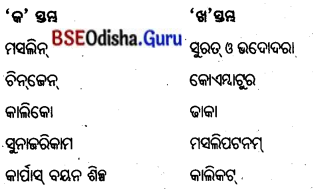
Answer:
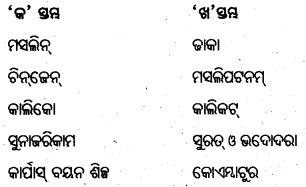
Question 2.
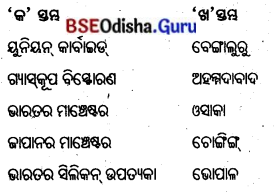
Answer:
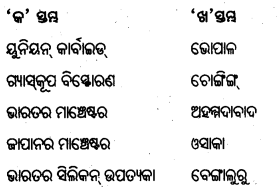
Question 3.
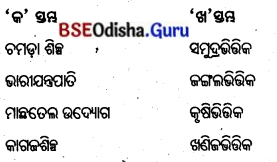
Answer:
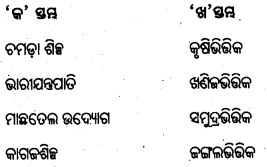
Question 4.
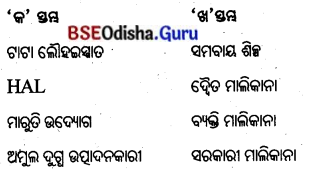
Answer:
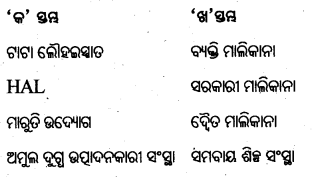
Question 5.
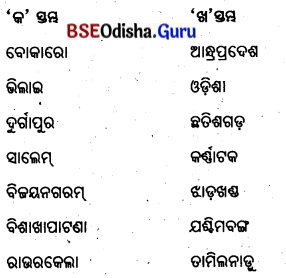
Answer:
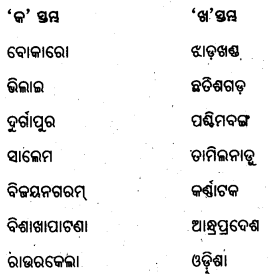

Question 6.
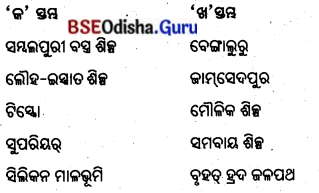
Answer:
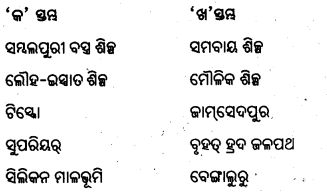
ବନ୍ଧନୀ ମଧ୍ଯରୁ ଉପଯୁକ୍ତ ଶବ୍ଦ ବାଛି ଶୂନ୍ୟସ୍ଥାନ ପୂରଣ କର ।
1. ________ ଦ୍ଵାରା ଆୟ ବୃଦ୍ଧି ପାଇଥାଏ।
(କୃଷି, ଖଣିଜ ଉତ୍ତୋଳନ, ମତ୍ସ୍ୟ ସଂଗ୍ରହ, ବାଣିଜ୍ୟ କାରବାର)
Answer: ବାଣିଜ୍ୟ କାରବାର
2. ଭାରୀ ଯନ୍ତ୍ରପାତି, ରେଳଡବା ନିର୍ମାଣ ________କାରଖାନା ଅନ୍ତର୍ଗତ ।
(କୃଷିଭିଭିକ, ଖଣିଜଭିର୍ଭିକ, ସମୁଦ୍ରଭିଭିକ, ଜଙ୍ଗଲଭିଭିକ
Answer: ଖଣିଜଭିଭିକ

3. ଚମଡ଼ା ଶିଳ୍ପ ______ଶିଳ୍ପର ଅନ୍ତର୍ଗତ ।
(କୃଷିଭିତ୍ତିକ, ଜଙ୍ଗଲଭିଭିକ, ଖଣିଜଭିଭିକ, ସମୁଦ୍ରାଭିଭିକ)
Answer: କୃଷିଭ୍ରିକ
4. ଗୃହନିର୍ମାଣ ଶିଳ୍ପ ______ ଶିଳ୍ପର ଅନ୍ତର୍ଗତ ।
(କୃଷିଭିଭିକ, ଖଣିଜଭିରିକ, ଜଙ୍ଗଲଭିଭିକ, ସମୁଦ୍ରଭିଭିକ)
Answer: ଜଙ୍ଗଲ ଭିଭିକ
5. ______ ପରିବାର ସଦସ୍ୟଙ୍କଦ୍ଵାରା କରାଯାଇଥାଏ।
(କ୍ଷୁଦ୍ରଶିଳ୍ପ, ବୃହତ୍ ଶିଳ୍ପ, କୁଟୀର ଶିଳ୍ପ, ଯାନ୍ତ୍ରିକ ଶିଳ୍ପ)
Answer: କୁଟୀର ଶିଳ୍ପ
6. ମଟର ଗାଡ଼ି ଓ ଭାରୀ ଯନ୍ତ୍ରପାତି ______ ର ଅନ୍ତର୍ଗତ ।
(କୁଟୀରଶିଳ୍ପ, କ୍ଷୁଦ୍ରଶିଳ୍ପ, ଜଙ୍ଗଲଭିଭିକ ଶିଳ୍ପ, ବୃହତ୍ଶିଳ୍ପ)
Answer: ବୃହତ୍ଶିଳ୍ପ
7. ମାଲିକାନା ଦୃଷ୍ଟିରୁ ଶିଳ୍ପକୁ ______ ଭାଗରେ ଭାଗ କରାଯାଇଛି ।
(ଏକ, ଦୁଇ, ତିନି, ଊରି)
Answer: ଗରି
8. ଟାଟା ଲୌହ ଇସ୍ପାତ କାରଖାନା ______ ଶିଚ୍ଛର ଅନ୍ତର୍ଗତ ।
(ବ୍ୟକ୍ତିମାଲିକାନା, ସରକାରୀ ମାଲିକାନା, ଦ୍ଵୈତ ମାଲିକାନା, ସମବାୟ ସଂସ୍ଥା)
Answer: ବ୍ୟକ୍ତିମାଲିକାନା
9. ଶିଳ୍ପସଂସ୍ଥାରୁ ସର୍ବଶେଷରେ ବାହାରୁଥିବା ଉତ୍ପାଦିତ ଦ୍ରବ୍ୟକୁ ______ କୁହାଯାଏ ।
(ନିବେଶ, ଉତ୍ପାଦ, କାରକ, ଆଧାରିକ ସଂରଚନା)
Answer: ଉତ୍ପାଦ
10. ୧୯୮୪ ମସିହା ଡିସେମ୍ବର ୩ ତାରିଖ ଦିନ ଭାରତର, _______ସହରରେ ଶିଳ୍ପଜନିତ ଦୁର୍ଘଟଣା ହୋଇଥିଲା।
(ଭୋପାଳ, ଚେନ୍ନାଇ, ରାୟପୁର, ଜୟପୁର)
Answer: ଗୋପାଳ

11. ୨୦୦୫ ମସିହାରେ ପୃଥିବୀର _______ ଦେଶରେ ଶିଳ୍ପ ଦୁର୍ଘଟଣା ହୋଇ ଅନେକ ଲୋକଙ୍କର ମୃତ୍ୟୁ ଘଟିଥିଲା।
(ଭାରତ, ଜାପାନ, ଚୀନ, ଇଂଲଣ୍ଡ)
Answer: ଚୀନ
12. କାଲିଫର୍ଡିଆ _______ଦେଶରେ ଅବସ୍ଥିତ ।
( ରୁଷିଆ, ଜାପାନ, ଯୁକ୍ତରାଷ୍ଟ୍ର ଆମେରିକା, ଚୀନ)
Answer: ଯୁକ୍ତରାଷ୍ଟ୍ର ଆମେରିକା
13. କାଲିଫର୍ଡିଆର ସିଲିକନ୍ _______ କ୍ଷେତ୍ରରେ ଅଗ୍ରଣୀ।
( ସୂଚନା ପ୍ରଯୁକ୍ତି ବିଦ୍ୟା, ଶିକ୍ଷା, ଶିଳ୍ପ, ସ୍ଵାସ୍ଥ୍ୟ)
Answer: ସୂଚନା ପ୍ରଯୁକ୍ତି ବିଦ୍ୟା
14. ଭାରତର _______ ସହର ସୂଚନା ପ୍ରଯୁକ୍ତି ବିଦ୍ୟାରେ ଅଗ୍ରଣୀ ସହର ।
(ପୁନେ, ଅହମ୍ମଦାବାଦ, ବେଙ୍ଗାଲୁରୁ, ମହୀଶୂର)
Answer: ବେଙ୍ଗାଲୁରୁ
15. ଲୌହ ଇସ୍ପାତ ଶିଳ୍ପ _______ ଶିଳ୍ପର ଅନ୍ତର୍ଗତ ।
(କୁଟୀର, କ୍ଷୁଦ୍ର, ସମବାୟ, ମୌଳିକ)
Answer: ମୌଳିକ
16. _______ କୁ ଆଧୁନିକ ଶିଳ୍ପ ଜଗତର ମେରୁଦଣ୍ଡ କୁହାଯାଏ।
(ସୁନା, ଲୁହା, ଇସ୍ପାତ, ତମ୍ବା)
Answer: ଇସ୍ପାତ

17. ୧୯୪୭ ମସିହା ପୂର୍ବରୁ _______ ଲୌହ ଇସ୍ପାତ କାରଖାନା ଥିଲା ।
(ଗୀଉରକେଲା, ବୋକାରୋ, ବର୍ଣ୍ଣପୁର, ଜାମସେଦ୍ପୁର)
Answer: ଜାମସେଦପୁର
18. ଜାମସେଦ୍ପୁର ଲୌହ-ଇସ୍ପାତ କାରଖାନା _______ ଅବସ୍ଥିତ।
(ଝାଡ଼ଖଣ୍ଡ, ଉତ୍ତରାଖଣ୍ଡ, ଛତିଶଗଡ଼, ଓଡ଼ିଶା)
Answer: ଝାଡ଼ଖଣ୍ଡ
19. ଟାଟା ଲୌହ-ଇସ୍ପାତ କାରଖାନାର ସଂକ୍ଷିପ୍ତ ନାମ _______|
(ପୋସ୍କୋ, ଟିସ୍କୋ, ସେସ୍କୋ, ନେସ୍କୋ)
Answer: ଟିସ୍କୋ
20. _______ ଟାଟା ଲୌହ-ଇସ୍ପାତ୍ ଶିଳ୍ପକେନ୍ଦ୍ର ପ୍ରତିଷ୍ଠା ହୋଇଥିଲା।
(1906, 1907, 1908, 1909)
Answer: 1907
21. ପିଟ୍ସ୍ବର୍ଗ ଲୌହ-ଇସ୍ପାତ୍ କାରଖାନା,_______ଦେଶରେ ଅବସ୍ଥିତ ।
(ଭାରତ, ଇଂଲଣ୍ଡ, ଯୁକ୍ତରାଷ୍ଟ୍ର ଆମେରିକା, ରୁଷିଆ)
Answer: ଯୁକ୍ତରାଷ୍ଟ୍ର ଆମେରିକା
22. ପ୍ରଥମେ _______ଦେଶରେ କଳତନ୍ତର ପ୍ରସାର ଘଟିଥିଲା।
(ଯୁକ୍ତରାଷ୍ଟ୍ର ଆମେରିକା, ଗ୍ରେଟ୍ ବ୍ରିଟେନ୍, ଭାରତ, ଜର୍ମାନୀ)
Answer: ଗ୍ରେଟ୍ ବ୍ରିଟେନ୍
23. ଢାକାର _______ କାର୍ପାସ ବସ୍ତ୍ର ପୃଥୁବୀ ପ୍ରସିଦ୍ଧ ।
(ମସ୍ଲିନ, ଚିନ୍ନ, କାଲିକୋ, ସୁନା ଜରିକାମ)
Answer: ମସ୍ନ
24. ମସଲିପଟନମ୍ବର _______ କାର୍ପାସ ବସ୍ତ୍ର ପୃଥିବୀ ପ୍ରସିଦ୍ଧ ।
(ମସଲିନ୍, ଚିନ୍ନ, କାଲିକୋ, ସୁନା ଜରିକାମ)
Answer: ଚିନ୍ନ୍

25. କାଲିକଟର _______ କାର୍ପାସ ବସ୍ତ୍ର ପୃଥିବୀ ପ୍ରସିଦ୍ଧ ।
( ମସଲିନ୍, ଚିନ୍ନ, କାଲିକୋ, ସୁନା ଜରିକାମ)
Answer: କାଲିକୋ
26. _______ ଭାରତର ପ୍ରଥମ ଆଧୁନିକ କାର୍ପାସ୍ ବୟନଶିଳ୍ପ ମୁମ୍ବାଇରେ ପ୍ରତିଷ୍ଠିତ ହୋଇଥିଲା ।
(1851, 1852, 1853, 1854)
Answer: 1854
27. ଅହମଦାବାଦ _______ ନଦୀକୂଳରେ ଅବସ୍ଥିତ ।
(ନର୍ମଦା, ସାବରମତୀ, ତାଣ୍ଡୀ, ମାହୀ)
Answer: ସାବରମ
28. _______ ପ୍ରଥମେ ଅହମ୍ମଦାବାଦରେ କାର୍ପାସ ବୟନ ଶିଳ୍ପ ପ୍ରତିଷ୍ଠିତ ହୋଇଥିଲା ।
(1856, 1857, 1858, 1859)
Answer: 1859
29. _______ କୁ ଭାରତର୍ ମାଞ୍ଚେଷ୍ଟର କୁହାଯାଏ।
(ଅହମ୍ମଦନଗର, ଅହମ୍ମଦାବାଦ, ହାଇଦ୍ରାବାଦ, ଜୟପୁର)
Answer: ଅହମ୍ମଦାବାଦ
30. ମାଞ୍ଚେଷ୍ଟର _______ ରେ ଅବସ୍ଥିତ ।
(ଭାରତ, ଯୁକ୍ତରାଷ୍ଟ୍ର ଆମେରିକା, ଇଂଲଣ୍ଡ, ଜାପାନ)
Answer: ଇଂଲଣ୍ଡ
ସମ୍ଭାବ୍ୟ ଉତ୍ତର ବାଛି ଲେଖ ।
Question 1.
କେଉଁଟି ପ୍ରାଥମିକ ଉତ୍ପାଦର ଅନ୍ତର୍ଗତ ?
(A) ଫଳ ଓ ମୂଳ
(B) ଘଣ୍ଟା ଓ ଯନ୍ତ୍ରପାତି
(C) କଲମ ଓ ମୋବାଇଲ
(D) ଲୁଗା ଓ କାଗଜ
Answer:
(A) ଫଳ ଓ ମୂଳ

Question 2.
କେଉଁଟି ପ୍ରକ୍ରିୟାକରଣ ପରେ ଆମେ ବ୍ୟବହାର କରିଥାଉ ?
(A) କାଗଜ
(B) ଫଳ
(C) ମହୁ
(D) ମୂଳ
Answer:
(A) କାଗଜ
Question 3.
କେଉଁ ସେବା କାର୍ଯ୍ୟକୁ ଶିଳ୍ପର ଅନ୍ତର୍ଭୁକ୍ତ କରାଯାଇଛି ?
(A) ଶିକ୍ଷା ଓ ସ୍ୱାସ୍ଥ୍ୟ
(B) ବ୍ୟାଙ୍କ୍ ଓ ପର୍ଯ୍ୟଟନ
(C) ପରିବହନ ଓ ଯୋଗାଯୋଗ
(D) ବ୍ୟାଙ୍କ୍ ଓ ଶିକ୍ଷା
Answer:
(C) ପରିବହନ ଓ ଯୋଗାଯୋଗ
Question 4.
କେଉଁଟି କୃଷିଭିତ୍ତିକ ଶିଳ୍ପର ସ୍ତର ଅଟେ ?
(A) ଭାରୀ ଯନ୍ତ୍ରପାତି, ରେଳଡ଼ବା ନିର୍ମାଣ, ମାଛତେଲ
(B) ଖାଦ୍ୟ ପ୍ରକ୍ରିୟାକରଣ, ଖାଇବାତେଲ ଉତ୍ପାଦନ, କାର୍ପାସ ବୟନ
(C) ମାଛତେଲ, ଚମଡ଼ାଶିଳ୍ପ, ଯନ୍ତ୍ରପାତି ନିର୍ମାଣ
(D) କାଠମଣ୍ଡ, କାଗଜ, ଆସବାବଶିଳ୍ପ
Answer:
(B) ଖାଦ୍ୟ ପ୍ରକ୍ରିୟାକରଣ, ଖାଇବାତେଲ ଉତ୍ପାଦନ, କାର୍ପାସ ବୟନ
Question 5.
କେଉଁଟି ସମୁଦ୍ରଭିତ୍ତିକ ଶିଳ୍ପ ଅଟେ ?
(A) ଖାଦ୍ୟ ପ୍ରକ୍ରିୟାକରଣ ଓ କାର୍ପାସ ବୟନ
(B) ଚମଡ଼ାଶିକ ଓ ଭାରି ଯନ୍ତ୍ରପାତି
(C) ସାମୁଦ୍ରିକ ଉଦ୍ୟୋଗ ଓ ମାଛତେଲ
(D) କାଠମତ୍ସ୍ୟ ଓ କାଗଜଶିଳ୍ପ
Answer:
(C) ସାମୁଦ୍ରିକ ଉଦ୍ୟୋଗ ଓ ମାଛତେଲ

Question 6.
କେଉଁଟି ଜଙ୍ଗଲଭିଭିକ ଶିଳ୍ପ ନୁହେଁ ?
(A) କାଠମଣ୍ଡ
(B) କାଗଜ ଶିକ
(C) ଔଷଧ ପ୍ରସ୍ତୁତକାରୀ ଶିଳ୍ପ
(D) ମଛତେଲ
Answer:
(D) ମଛତେଲ
Question 7.
କେଉଁଟି କୁଟୀର ଶିଳ୍ପର ଅନ୍ତର୍ଗତ ନୁହେଁ ?
(A) ତାରକସି କାମ
(B) ଝାଡ଼ୁବୁଣା
(C) ମାଟିହାଣ୍ଡି ନିର୍ମାଣ
(D) ଘଣ୍ଟା ନିର୍ମାଣ
Answer:
(D) ଘଣ୍ଟା ନିର୍ମାଣ
Question 8.
କେଉଁଟି କ୍ଷୁଦ୍ରଶିଳ୍ପର ଅନ୍ତର୍ଗତ ନୁହେଁ ?
(A) ଘଣ୍ଟା
(B) ରେଡିଓ ନିର୍ମାଣ
(C) ମାଟିହାଣ୍ଡି ପ୍ରସ୍ତୁତି
(D) ଟିଭି ତିଆରି
Answer:
(C) ମାଟିହାଣ୍ଡି ପ୍ରସ୍ତୁତି
Question 9.
HAL ଏବଂ SAIL(ହିନ୍ଦୁସ୍ତାନ ଏରୋନଟିକ୍ସ ଲିମିଟେଡ୍ ଓ ଭାରତୀୟ ଇସ୍ପାତନିଗମ) କେଉଁ ଶିଳ୍ପର ଅନ୍ତର୍ଗତ ?
(A) ବ୍ଯକ୍ତିମାଲିକାନା
(B) ସରକାରୀ ମାଲିକାନା
(C) ଦ୍ଵୈତ ମାଲିକାନା
(D) ସମବାୟ ସଂସ୍ଥା
Answer:
(B) ସରକାରୀ ମାଲିକାନା
Question 10.
କେଉଁଟି ଦ୍ଵୈତ ମାଲିକାନା ଶିଳ୍ପର ଅନ୍ତର୍ଗତ ?
(A) ଟାଟା ଲୌହଇସ୍ପାତ
(B) ଭାରତୀୟ ଇସ୍ପାତ ନିଗମ
(C) ମାରୁତି ଉଦ୍ୟୋଗ
(D) ଅମୁଲ ଶିଳ୍ପ
Answer:
(C) ମାରୁତି ଉଦ୍ୟୋଗ

Question 11.
ସମ୍ବଲପୁରୀ ବସ୍ତଶିଳ୍ପ ଓ ଅମୁଲ ଦୁଗ୍ଧ ଉତ୍ପାଦନକାରୀ ସଂସ୍ଥା କେଉଁ ଶିଳ୍ପର ଅନ୍ତର୍ଗତ ?
(A) ବ୍ୟକ୍ତି ମାଲିକାନା
(B) ସରକାରୀ ମାଲିକାନା
(C) ଦ୍ଵୈତ ମାଲିକାନା
(D) ସମବାୟ ସଂସ୍ଥା
Answer:
(D) ସମବାୟ ସଂସ୍ଥା
Question 12.
କେଉଁଟି ଆଧାରିକ ସଂରଚନାର ଅନ୍ତର୍ଗତ ନୁହେଁ ?
(A) ବିଦ୍ୟୁତକରଣ
(B) କଞ୍ଚାମାଲ
(C) ଯୋଗାଯୋଗ
(D) ସଡ଼କ
Answer:
(B) କଞ୍ଚାମାଲ
Question 13.
କେଉଁଟି ଶିଳ୍ପ ବ୍ୟବସ୍ଥାର ନିବେଶର ଅନ୍ତର୍ଗତ ନୁହେଁ ?
(A) କଞ୍ଚାମାଲ
(B) ଶ୍ରମିକ
(C) ଭୂମି
(D) ଅରଣ୍ୟ
Answer:
(D) ଅରଣ୍ୟ
Question 14.
ଶିଳ୍ପସଂସ୍ଥାରେ କଞ୍ଚାମାଲରୁ ଉତ୍ପାଦ ସୃଷ୍ଟି ହେବାପାଇଁ ଯେଉଁସବୁ କାର୍ଯ୍ୟପନ୍ଥା ଗ୍ରହଣ କରାଯାଏ, ତାହାକୁ କ’ଣ କୁହାଯାଏ ?
(A) କାରକ
(B) ନିବେଶ
(C) ପ୍ରକ୍ରିୟାକରଣ
(D) ଉତ୍ପାଦ
Answer:
(C) ପ୍ରକ୍ରିୟାକରଣ

Question 15.
କେଉଁଟି ଭାରତର ଶିଳ୍ପାଞ୍ଚଳ ନୁହେଁ ?
(A) ମୁମ୍ବାଇ – ପୁଣେ
(B) ବେଙ୍ଗାଲୁରୁ – ତାମିଲନାଡୁ
(C) ଗୁଡଗାଓଁ – ଦିଲ୍ଲୀ – ମିରଟ୍
(D) କଟକ – ଓଡ଼ିଶା
Answer:
(D) କଟକ – ଓଡ଼ିଶା
Question 16.
କେଉଁଟି ପୃଥିବୀର ଶିଳ୍ପାଞ୍ଚଳ ନୁହେଁ ?
(A) ଆମେରିକା ପୂବାଂଶ
(B) ପାକିସ୍ଥାନର ପୂର୍ବାଶ
(C) ପଶ୍ଚିମ ଓ କେନ୍ଦ୍ରୀୟ ୟୁରୋପ
(D) ପୂର୍ବ ଏସିଆ ଓ ପୂର୍ବ ୟୁରୋପ
Answer:
(B) ପାକିସ୍ଥାନର ପୂର୍ବାଶ
Question 17.
କେଉଁଟି ‘ସୂର୍ଯ୍ୟୋଦୟ ଶିଳ୍ପ’ର ଅନ୍ତର୍ଗତ ନୁହେଁ ?
(A) ସୂଚନା ପ୍ରଯୁକ୍ତି ବିଦ୍ୟା
(B) ସ୍ଵାସ୍ଥ୍ୟ ଓ ସ୍ଵାସ୍ଥ୍ୟ ସେବା
(C) ଆତିଥ୍ୟ ଓ ସେବା
(D) ଲୌହ-ଇସ୍ପାତ ଶିଳ୍ପ
Answer:
(D) ଲୌହ-ଇସ୍ପାତ ଶିଳ୍ପ
Question 18.
କେଉଁଟି ଇସ୍ପାତ ଧାତୁ ପ୍ରସ୍ତୁତିରେ ବ୍ୟବହାର କରାଯାଏ ନାହିଁ ?
(A) ମାଙ୍ଗାନିକ
(B) ଆଲୁମିନିୟମ୍
(C) ନିକେଲ
(D) କ୍ରୋମିୟମ୍
Answer:
(B) ଆଲୁମିନିୟମ୍
Question 19.
କେଉଁ ଲୌହ-ଇସ୍ପାତ କାରଖାନା ଭିନ୍ନ ଅଟେ ?
(A) ଝାଡ଼ଖଣ୍ଡ – ଜାମସେଦ୍ପୁର
(B) ଓଡ଼ିଶା – ରାଉରକେଲା
(C) ତାମିଲନାଡୁ – ଭଦ୍ରାବତୀ
(D) ପଶ୍ଚିମବଙ୍ଗ – ଦୁର୍ଗାପୁର
Answer:
(C) ତାମିଲନାଡୁ – ଭଦ୍ରାବତୀ

Question 20.
କେଉଁ ନଦୀଦ୍ୱୟରୁ ଜାମସେଦପୁର ଲୌହଇସ୍ପାତ୍ କାରଖାନାକୁ ପ୍ରଚୁର ଜଳ ଯୋଗାଇ ଦିଆଯାଇଥାଏ ?
(A) ମହାନଦୀ ଓ ବ୍ରାହ୍ମଣୀ
(B) ଗୋଦାବରୀ ଓ କୋଏନା
(C) ଖରକାଇ ଓ ସୁବର୍ଣ୍ଣରେଖା
(D) ସୁବର୍ଣ୍ଣରେଖା ଓ ବୁଢାବଳଙ୍ଗ
Answer:
(C) ଖରକାଇ ଓ ସୁବର୍ଣ୍ଣରେଖା
Question 21.
ଟାଟା ଲୌହ-ଇସ୍ପାତ କାରଖାନାଟି କେଉଁ ରେଳପଥ ନିକଟରେ ଅବସ୍ଥିତ ?
(A) ହାୱଡ଼ା – ଦୁର୍ଗାପୁର
(B) ହାୱଡ଼ା ଚନ୍ଦନନଗର
(C) ହାୱଡ଼ା – ମୁମ୍ବାଇ
(D) ହାୱଡ଼ା – ସାଲିମାର
Answer:
(C) ହାୱଡ଼ା – ମୁମ୍ବାଇ
Question 22.
ଭଦ୍ରାବତୀ ଓ ବିଜୟନଗର ଲୌହ-ଇସ୍ପାତ୍ କାରଖାନା କେଉଁ ରାଜ୍ୟରେ ଅବସ୍ଥିତ ?
(A) ଓଡ଼ିଶା
(B) କର୍ଣାଟକ
(C) ପଶ୍ଚିମବଙ୍ଗ
(D) ତାମିଲନାଡୁ
Answer:
(B) କର୍ଣାଟକ
Question 23.
କେଉଁଟି କାର୍ପାସ ଶିଳ୍ପରେ ଅଗ୍ରଣୀ ଦେଶ ନୁହେଁ ?
(A) ଭାରତ
(B) ଚୀନ
(C) ଜାପାନ
(D) ଶ୍ରୀଲଙ୍କା
Answer:
(D) ଶ୍ରୀଲଙ୍କା
Question 24.
ସୁନା ଜରିକାମ କାର୍ପାସ ବସ୍ତ୍ର କେଉଁ ଅଞ୍ଚଳରେ ପ୍ରସ୍ତୁତ କରାଯାଏ ?
(A) ସୁରତ ଓ ଇଦୋଦରା
(B) ଜୟପୁର ଓ ଆଜମିର
(C) ପୁନେ ଓ ମୁମ୍ବାଇ
(D) ନାଗପୁର ଓ ଥାନେ
Answer:
(A) ସୁରତ ଓ ଇଦୋଦରା
Question 25.
କେଉଁଟି କାର୍ପାସ ଶିଳ୍ପର ଅନ୍ତର୍ଗତ ନୁହେଁ ?
(A) କୋଏମ୍ବାଟୁର
(B) କାନପୁର
(C) ଚେନ୍ନାଇ
(D) ବର୍ଣ୍ଣପୁର
Answer:
(D) ବର୍ଣ୍ଣପୁର

Question 26.
ଅହମ୍ମଦାବାଦରେ କାର୍ପାସ ବୟନ ଶିଳ୍ପ ଗଢ଼ିଉଠିବାର କାରଣ କ’ଣ ?
(A) କଞ୍ଚାମାଲର ସୁଲଭତା
(B) ପୁଞ୍ଜି
(C) ଶ୍ରମ
(D) ପରିବହନ
Answer:
(A) କଞ୍ଚାମାଲର ସୁଲଭତା
Question 27.
କାହାକୁ ‘ଜାପାନର ମାଞ୍ଚେଷ୍ଟର’ କୁହାଯାଏ ?
(A) ଟୋକିଓ
(B) ଓସାକା
(C) ସିକାଗୋ
(D) କ୍ରିଟୋ
Answer:
(B) ଓସାକା
Question 28.
କେଉଁ ନଦୀରୁ ଓସାକା ବୟନଶିଳ୍ପ ପାଇଁ ପ୍ରଚୁର ଜଳ ଯୋଗାଇଥାଏ ?
(A) ଓଜୋ
(B) ସିଜୋ
(C) କ୍ଲିଟୋ
(D) ମିତୃବିସି
Answer:
(A) ଓଜୋ
Question 29.
ଭାରତର କେଉଁଠାରେ ସୂଚନା ପ୍ରଯୁକ୍ତି ବିଦ୍ୟାର ପ୍ରଧାନ କେନ୍ଦ୍ର ଅଟେ ?
(A) ମୁମ୍ବାଇ
(B) ଦିଲ୍ଲୀ
(C) ବେଙ୍ଗାଲୁରୁ
(D) ମହୀଶୂର
Answer:
(C) ବେଙ୍ଗାଲୁରୁ
Question 30.
କାହାକୁ ଭାରତର ସିଲିକନ ମାଳଭୂମି କୁହାଯାଏ ?
(A) ବେଙ୍ଗାଲୁରୁ
(B) ରାୟପୁର
(C) କୋଲକାତା
(D) ଭୁବନେଶ୍ଵର
Answer:
(A) ବେଙ୍ଗାଲୁରୁ

Question 31.
“କାଲିଫର୍ନିଆର ସିଲିକନ୍ ଉପତ୍ୟକା” କେଉଁ ଦେଶରେ ଅବସ୍ଥିତ ?
(A) ଜାପାନ
(B) ଜର୍ମାନୀ
(C) ରୁଷିଆ
(D) ଯୁକ୍ତରାଷ୍ଟ୍ର ଆମେରିକା
Answer:
(D) ଯୁକ୍ତରାଷ୍ଟ୍ର ଆମେରିକା
Question 32.
କେବେ କର୍ଣାଟକ ସରକାର ସର୍ବପ୍ରଥମେ ସୂଚନା ଓ ପ୍ରଯୁକ୍ତି ବିଦ୍ୟା ଆଇନ ପ୍ରଣୟନ କରିଥିଲେ ?
(A) 1991
(B) 1992
(C) 1993
(D) 1994
Answer:
(B) 1992
Question 33.
କେଉଁଟି ସିଲିକନ ଉପତ୍ୟକାର ବିଶେଷତ୍ଵ ନୁହେଁ ?
(A) ନାତିଶୀତୋଷ ଜଳବାୟୁ
(B) ଆକର୍ଷିତ ସୁନିର୍ମଳ ପରିବେଶ
(C) ପରିବହନ ସୁଯୋଗ
(D) ଅସ୍ୱାସ୍ଥ୍ୟକର ପରିବେଶ
Answer:
(D) ଅସ୍ୱାସ୍ଥ୍ୟକର ପରିବେଶ
Question 34.
ଭାରତର କେଉଁ ସହରରେ ସୂଚନା ଓ ପ୍ରଯୁକ୍ତି ବିଦ୍ୟାର ନୂତନ କେନ୍ଦ୍ରମାନ ଗଢ଼ିଉଠି ନାହିଁ ?
(A) ମୁମ୍ବାଇ
(B) ରାୟପୁର
(C) ନୂଆଦିଲ୍ଲୀ
(D) ହାଇଦ୍ରାବାଦ
Answer:
(B) ରାୟପୁର
Question 35.
ଇନ୍ଫୋସିସ୍ ଓ ୱିପ୍ରୋ କେଉଁ ଶିଳ୍ପ ସଂସ୍ଥାର ଅଟନ୍ତି ?
(A) ଲୌହ-ଇସ୍ପାତ
(B) କାର୍ପାସ
(C) ସୂଚନା ଓ ପ୍ରଯୁକ୍ତି ବିଦ୍ୟା
(D) କାଗଜ
Answer:
(C) ସୂଚନା ଓ ପ୍ରଯୁକ୍ତି ବିଦ୍ୟା

Question 36.
ଆମେରିକୀୟ କମ୍ପାନୀଗୁଡ଼ିକ ସେମାନଙ୍କର କୁଶଳୀ କର୍ମୀମାନଙ୍କୁ ନିଯୁକ୍ତି ଦେଇ ଶସ୍ତା ଓ ସମକୁଶଳୀ ଭାବରେ କେଉଁମାନଙ୍କୁ ନିଯୁକ୍ତି ଦେଇଥାନ୍ତି ?
(A) ଭାରତୀୟ
(B) ଚୀନା
(C) ରୁଷିଆ
(D) ଜାପାନୀ
Answer:
(A) ଭାରତୀୟ
Question 37.
କେଉଁଟି ବୃହତ୍ ହ୍ରଦ ଅଞ୍ଚଳର ଅନ୍ତର୍ଗତ ନୁହେଁ ?
(A) ସୁପିରିଅର୍
(B) ଭିକ୍ଟୋରିଆ
(C) ହ୍ୟୁରନ୍
(D) ମିଚିଗାନ୍
Answer:
(B) ଭିକ୍ଟୋରିଆ
Question 38.
କେଉଁ ଶିଳ୍ପଟି ପୃଥିବୀର ଏକ ପୁରାତନ ଶିଳ୍ପ ?
(A) ଲୌହଇସ୍ପାତ
(B) କାର୍ପାସ ବୟନ
(C) ଖଣିଜ ଉତ୍ତୋଳନ
(D) ସୂଚନା ପ୍ରଯୁକ୍ତି ବିଦ୍ୟା
Answer:
(B) କାର୍ପାସ ବୟନ
Question 39.
ଭବୋଦରା କେଉଁଥିପାଇଁ ପ୍ରସିଦ୍ଧ ?
(A) କାଲିକୋ ବସ୍ତ୍ର
(B) ଚିଜେନ୍
(C) ସୁନା ଜରିବସ୍ତ୍ର
(D) ମସ୍ଲିନ୍
Answer:
(C) ସୁନା ଜରିବସ୍ତ୍ର
Question 40.
1854 ମସିହାରେ କେଉଁଠାରେ ଭାରତର ପ୍ରଥମ ଆଧୁନିକ କାର୍ପାସ ଶିଳ୍ପ ପ୍ରତିଷ୍ଠିତ ହୋଇଥିଲା ?.
(A) କୋଲକାତା
(B) ସୁରତ୍
(C) ମୁମ୍ବାଇ
(D) ଅହମ୍ମଦାବାଦ
Answer:
(C) ମୁମ୍ବାଇ
Question 41.
କେଉଁ ନଦୀକୂଳରେ ଅହମ୍ମଦାବାଦ ସହର ଅବସ୍ଥିତ ?
(A) ଇରାବତୀ
(B) କାବେରୀ
(C) ନର୍ମଦା
(D) ସାବରମତି
Answer:
(D) ସାବରମତି
Question 42.
ଜାତୀୟ ବୟନଶିଳ୍ପର ଉତ୍ପାଦିତ ସାମଗ୍ରୀର କେତେଭାଗ ବିଦେଶକୁ ରପ୍ତାନି ହୁଏ ?
(A) 1/2
(B) 1/3
(C) 1/5
(D) 2/3
Answer:
(B) 1/3
Question 43.
କେଉଁଟି ସେବାଶିଳ୍ପ ନୁହେଁ ?
(A) ପରିବହନ
(B) ପର୍ଯ୍ୟଟନ
(C) ଯୋଗାଯୋଗ
(D) କୋଇଲା ଖନନ
Answer:
(D) କୋଇଲା ଖନନ
Question 44.
କେବେ ଭୋପାଳ ଗ୍ୟାସ୍ ଦୁର୍ଘଟଣା ଘଟିଥିଲା ?
(A) 1984 Dec 3rd
(B) 1989 Jan 13
(C) 1988 Mar 31
(D) 1999 Aug 13
Answer:
(A) 1984 Dec 3rd
Question 45.
ଭଦ୍ରାବତୀ ଲୌହଇସ୍ପାତ କାରଖାନା କେଉଁ ରାଜ୍ୟରେ ଅବସ୍ଥିତ ?
(A) ଆନ୍ଧ୍ରପ୍ରଦେଶ
(B) ମଧ୍ୟପ୍ରଦେଶ
(C) କର୍ଣ୍ଣାଟକ
(D) ତାମିଲନାଡୁ
Answer:
(C) କର୍ଣ୍ଣାଟକ
Question 46.
କେଉଁ ଲୌହଇସ୍ପାତ କେନ୍ଦ୍ରଟି ପଶ୍ଚିମବଙ୍ଗରେ ଅବସ୍ଥିତ ?
(A) ଟିସ୍କୋ
(B) ଭିଲାଇ
(C) ବୋକାରୋ
(D) ବର୍ଣ୍ଣପୁର
Answer:
(D) ବର୍ଣ୍ଣପୁର

Question 47.
ଓଡ଼ୋ ନଦୀ କେଉଁ ଶିଳ୍ପକୁ ପ୍ରଚୁର ପାଣି ଯୋଗାଏ ?
(A) କାର୍ପାସ ବୟନ
(B) ଲୌହଇସ୍ପାତ
(C) କୋଇଲା ଖନନ
(D) ସୂଚନା ପ୍ରଯୁକ୍ତି ବିଦ୍ୟା
Answer:
(A) କାର୍ପାସ ବୟନ
Question 48.
କେଉଁ ରାଜ୍ୟ ସର୍ବପ୍ରଥମେ 1992 ମସିହାରେ ସୂଚନା ଓ ପ୍ରଯୁକ୍ତି ବିଦ୍ୟା ଆଇନ୍ ପ୍ରଣୟନ କରିଥିଲା ?
(A) ମହାରାଷ୍ଟ୍ର
(B) ତାମିଲନାଡୁ
(C) କର୍ଣ୍ଣାଟକ
(D) ଆନ୍ଧ୍ରପ୍ରଦେଶ
Answer:
(C) କର୍ଣ୍ଣାଟକ
![]()
![]()
![]()

